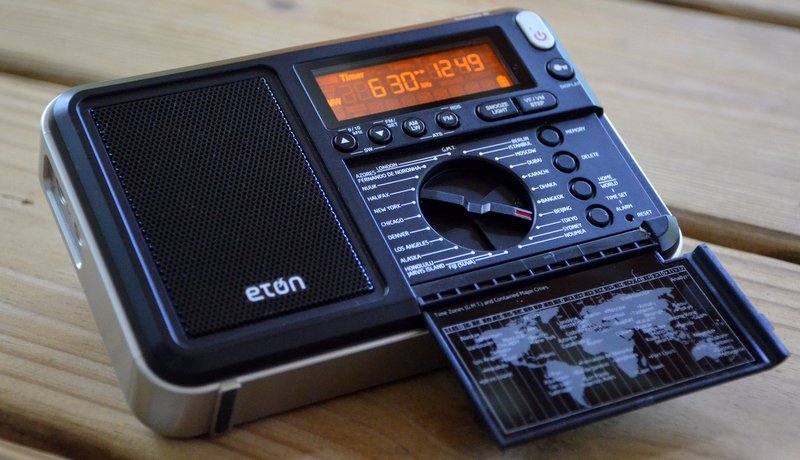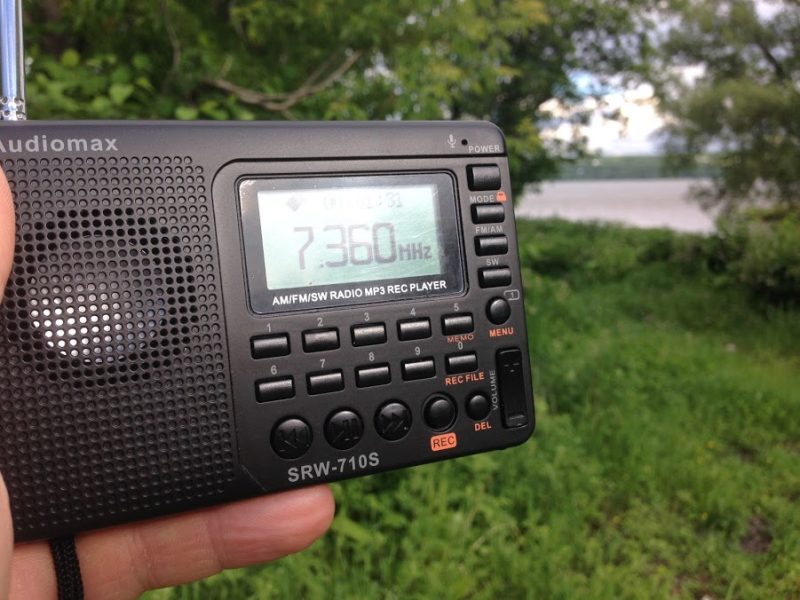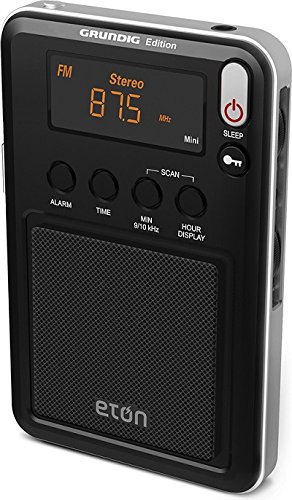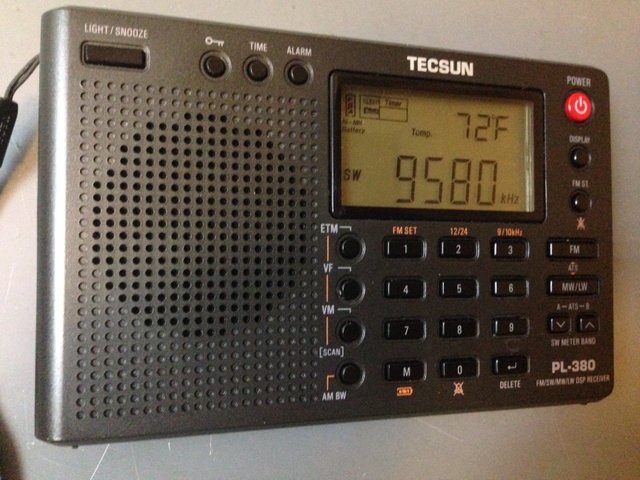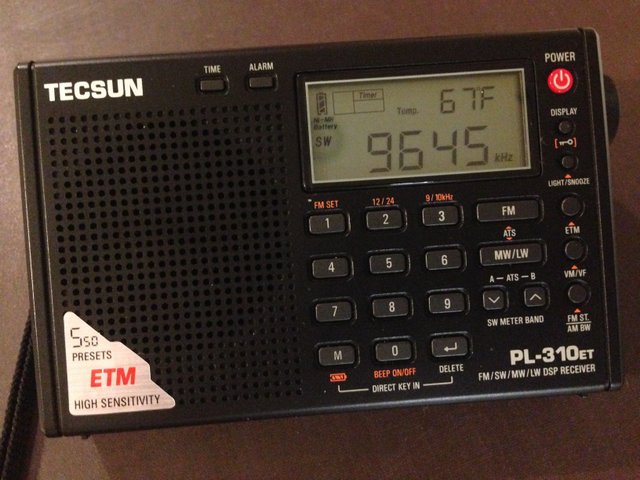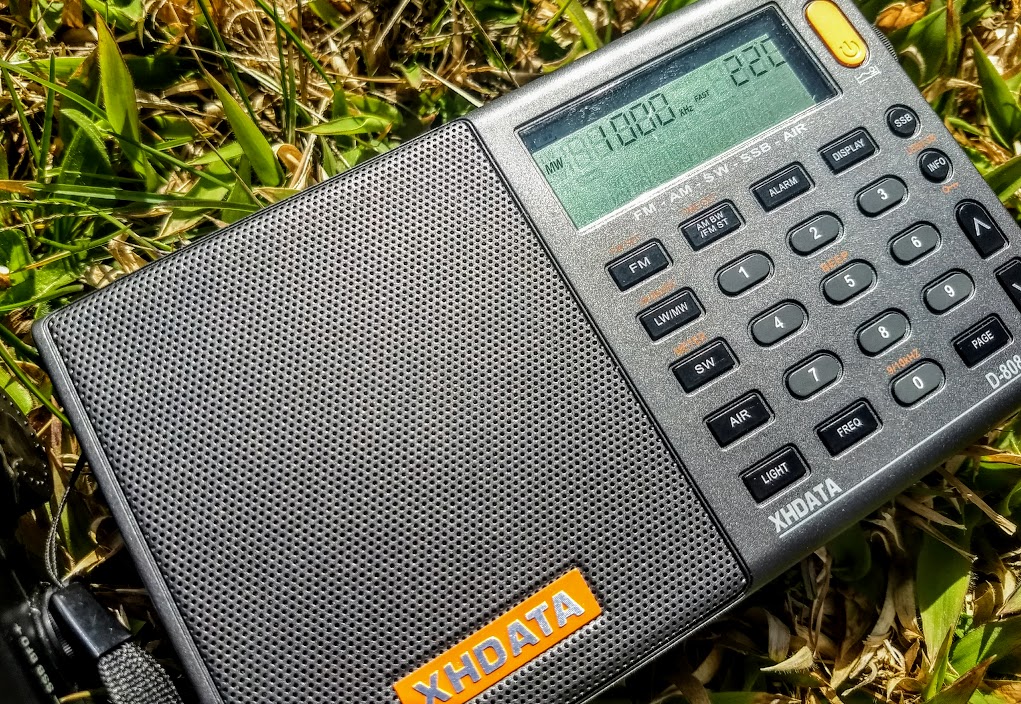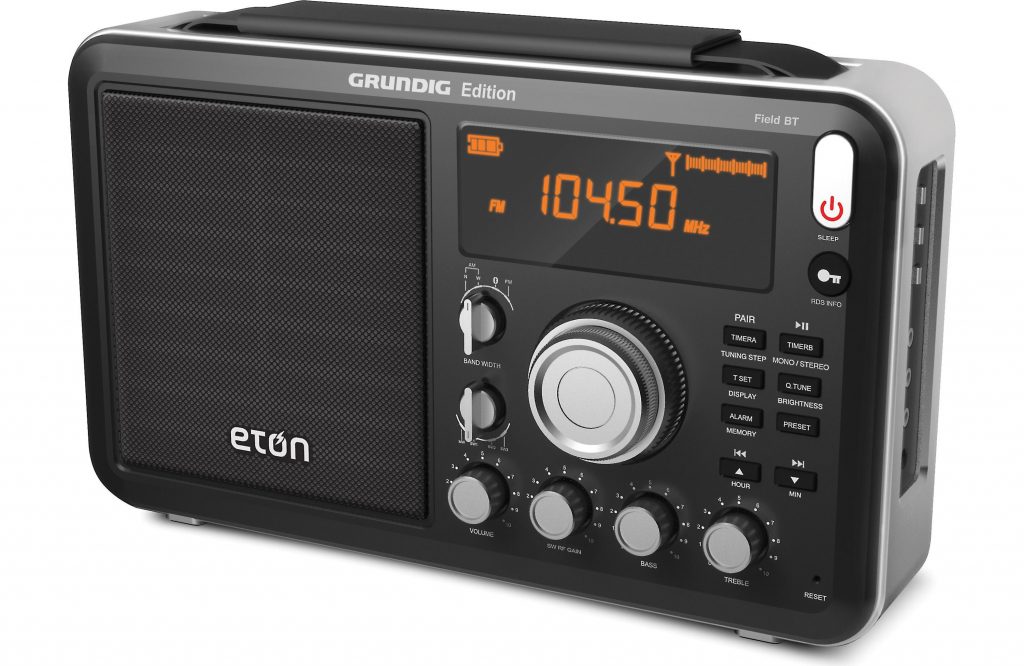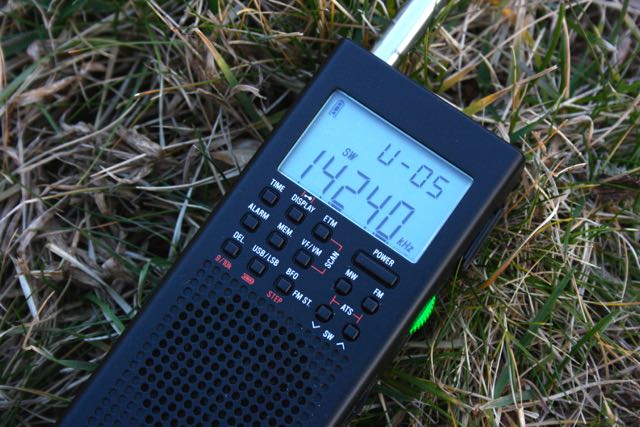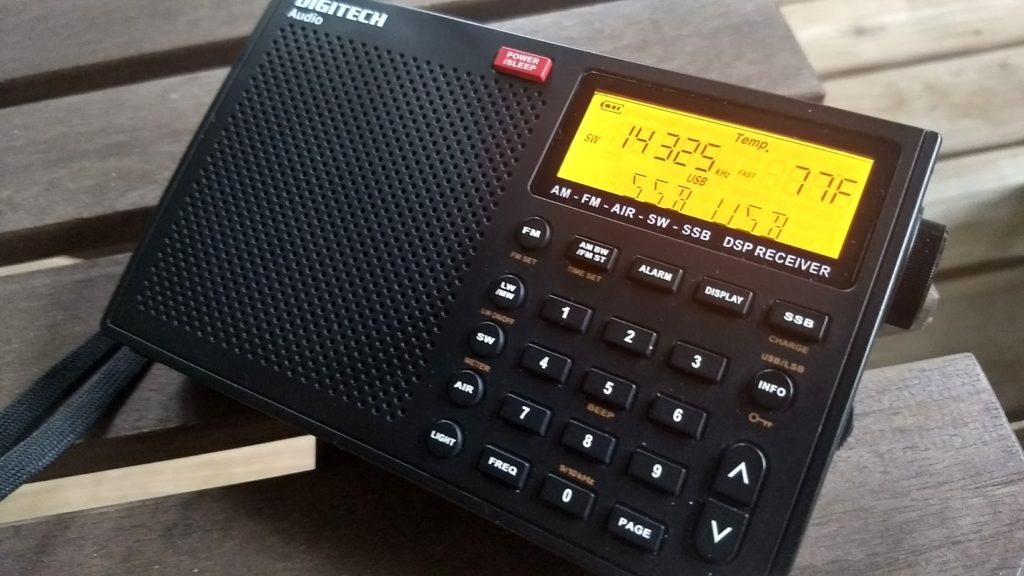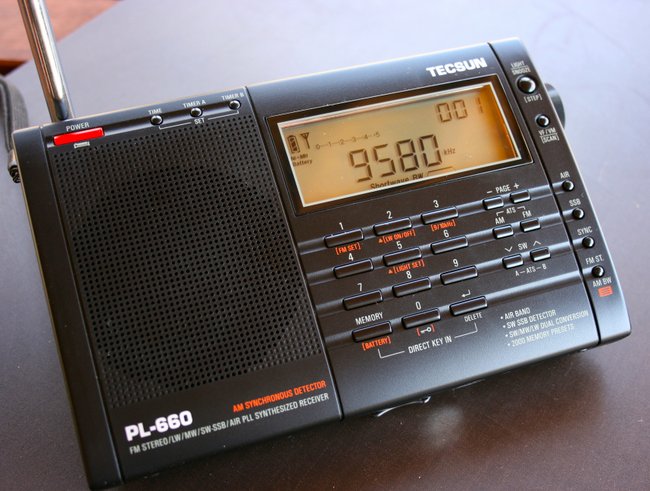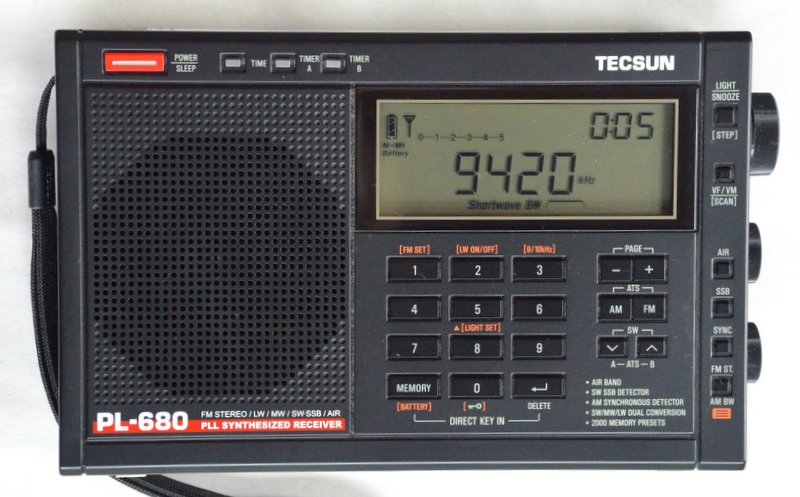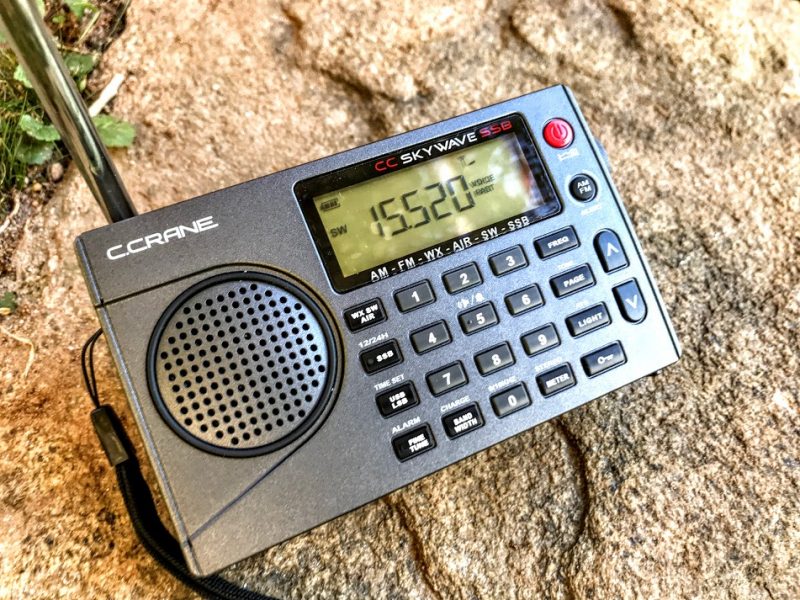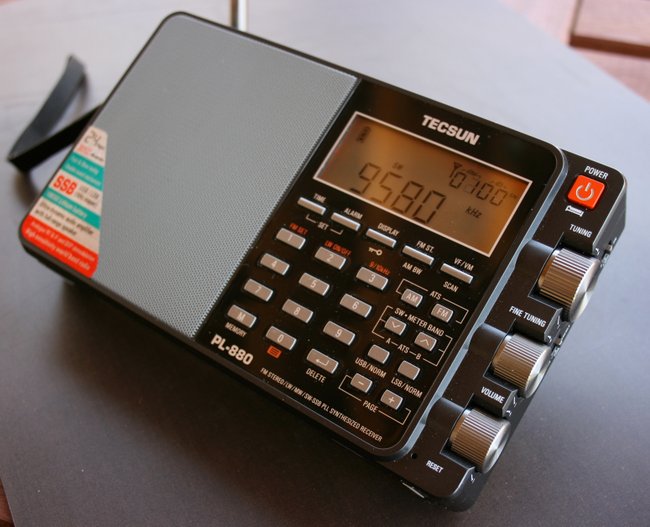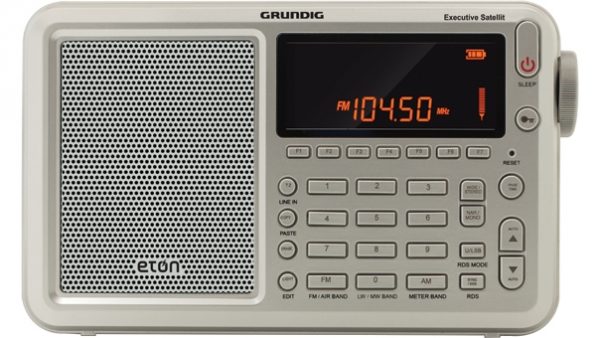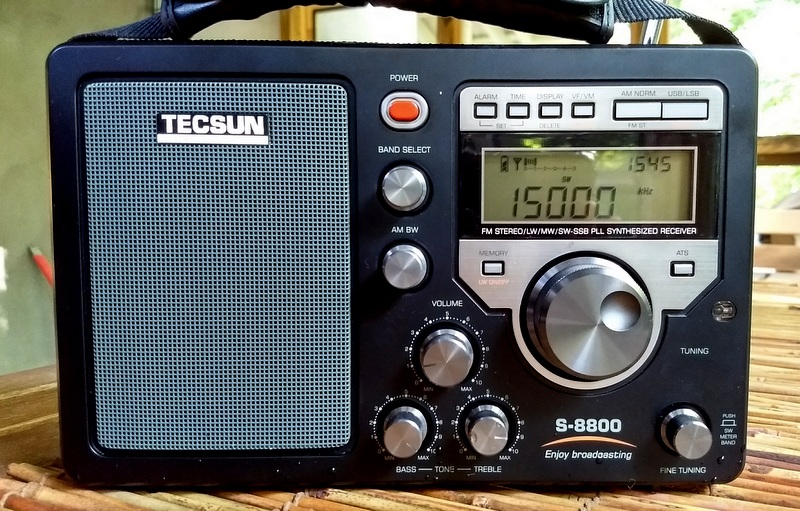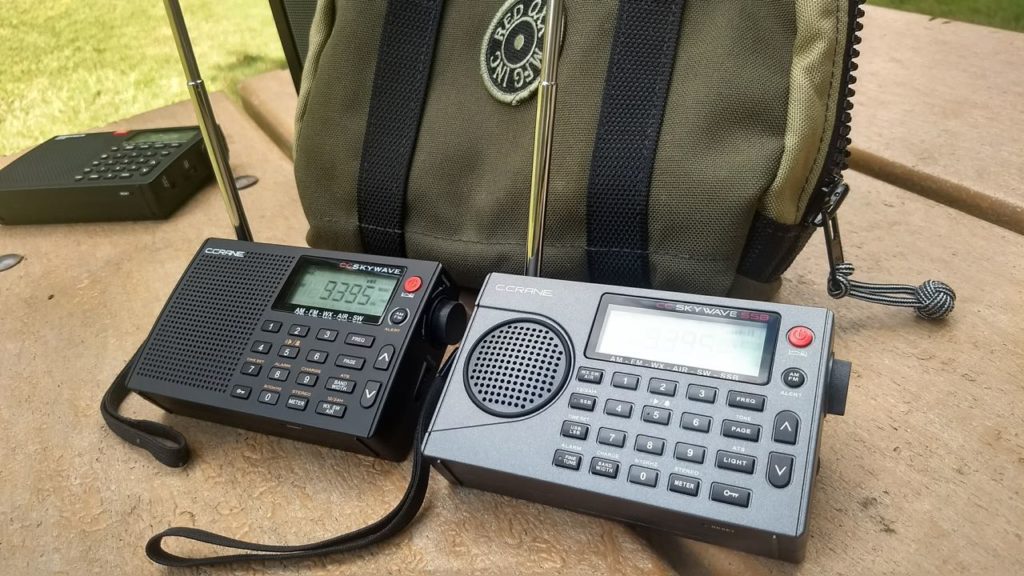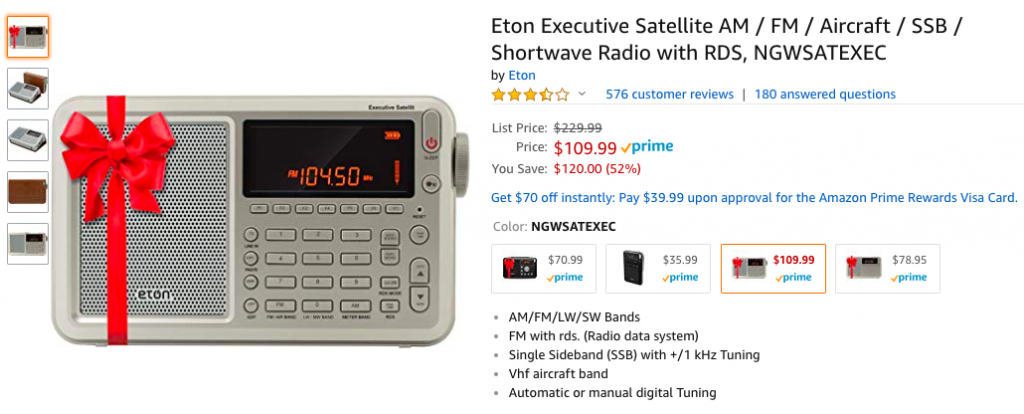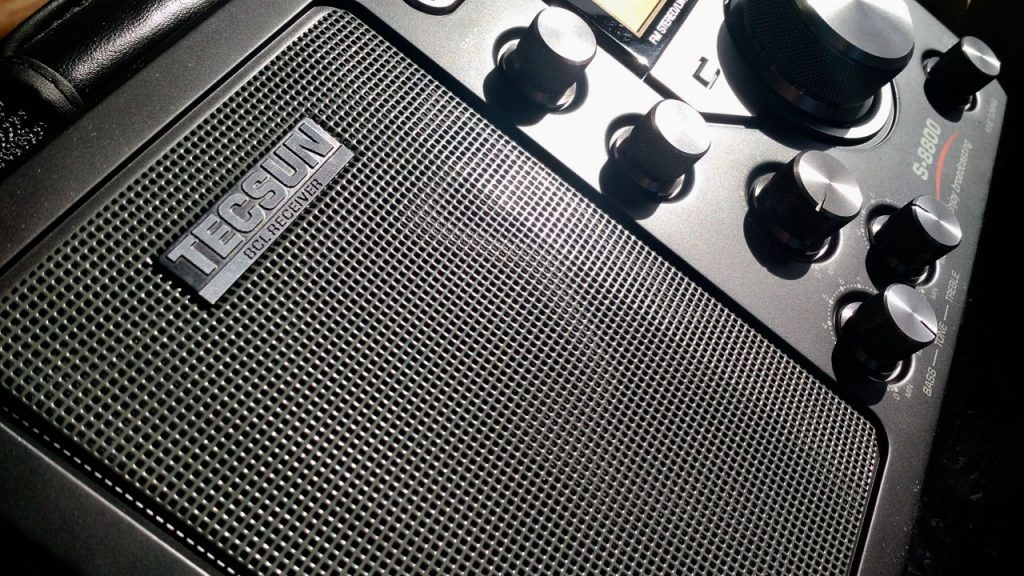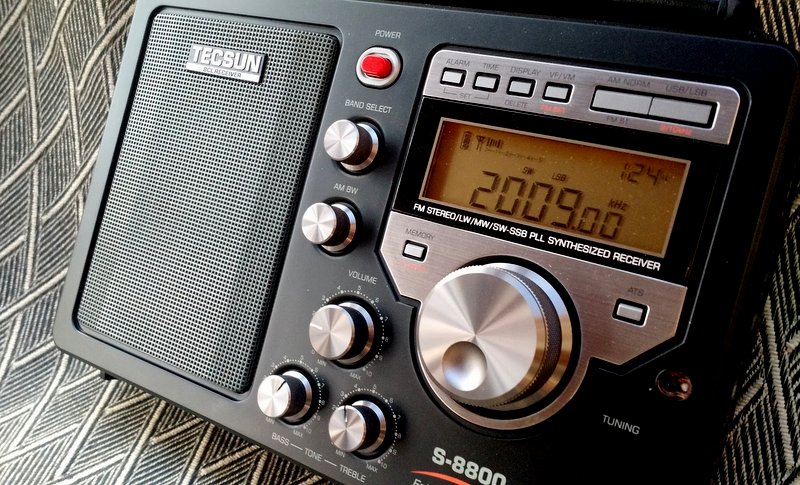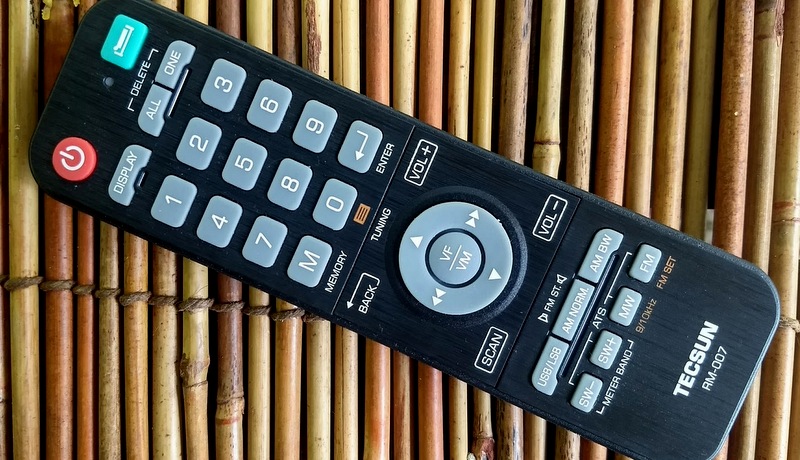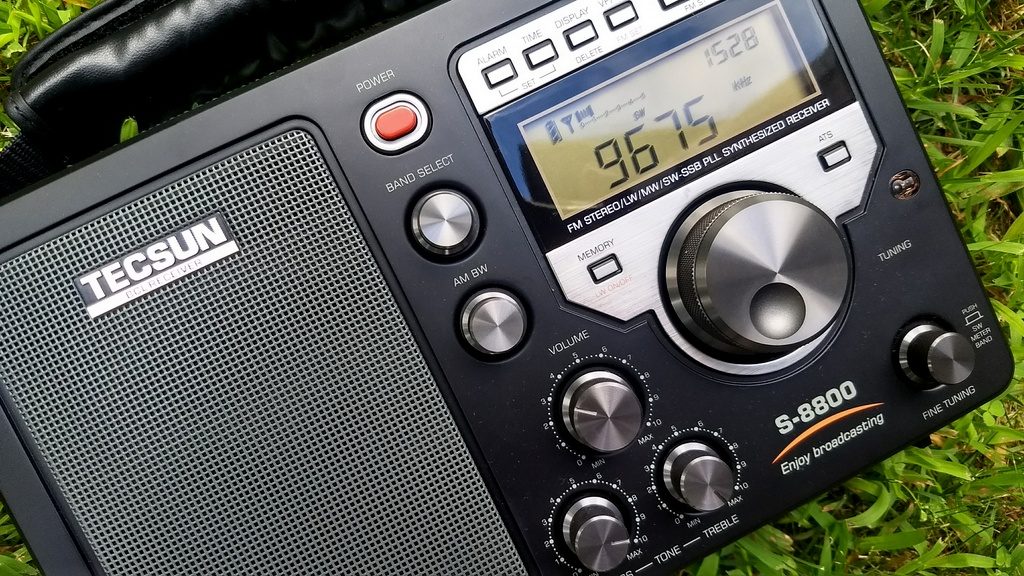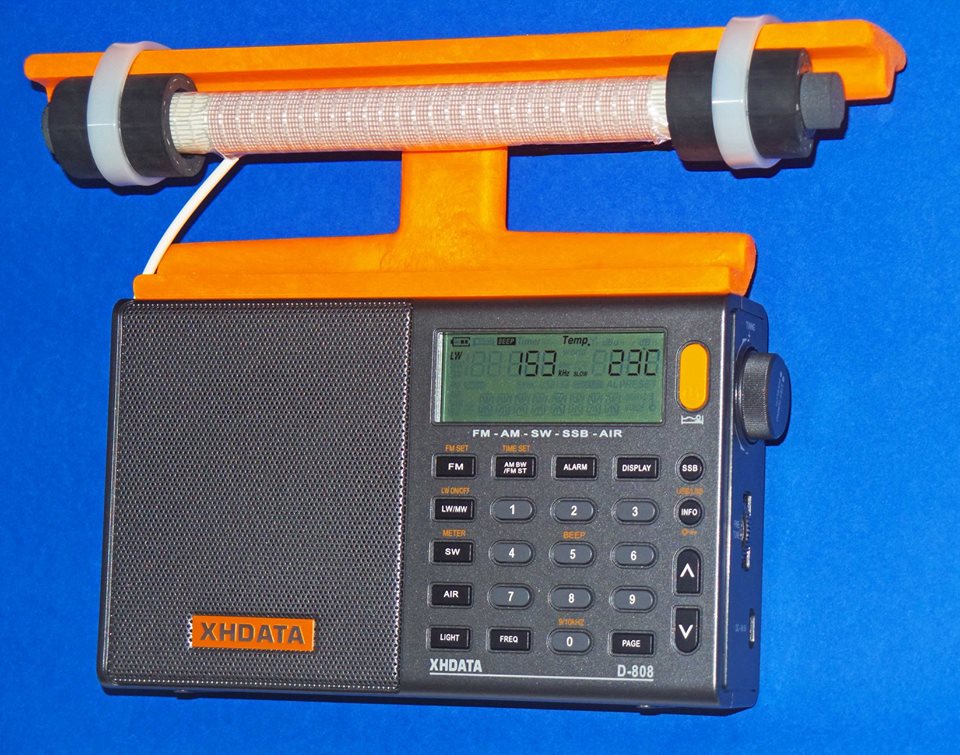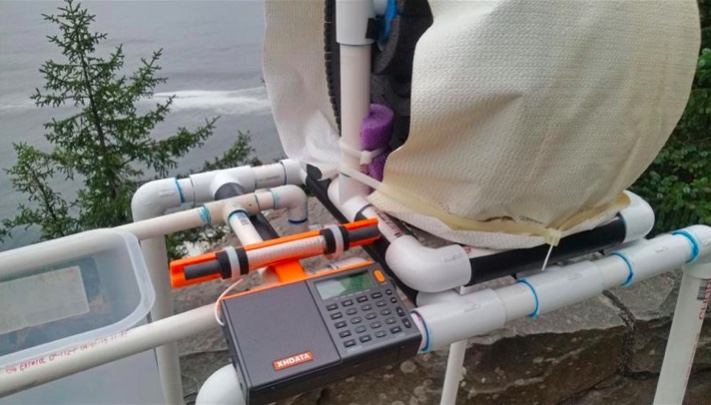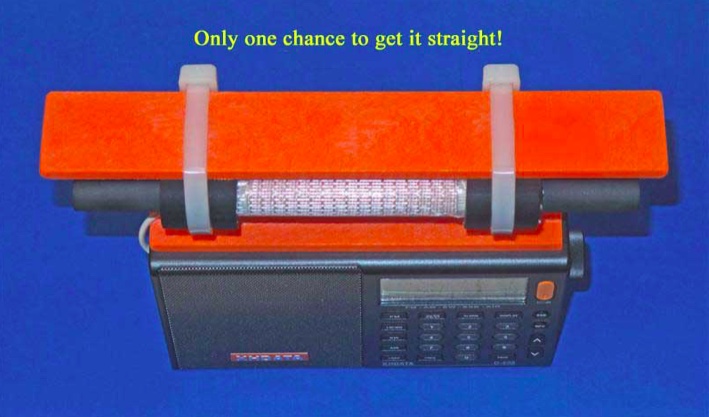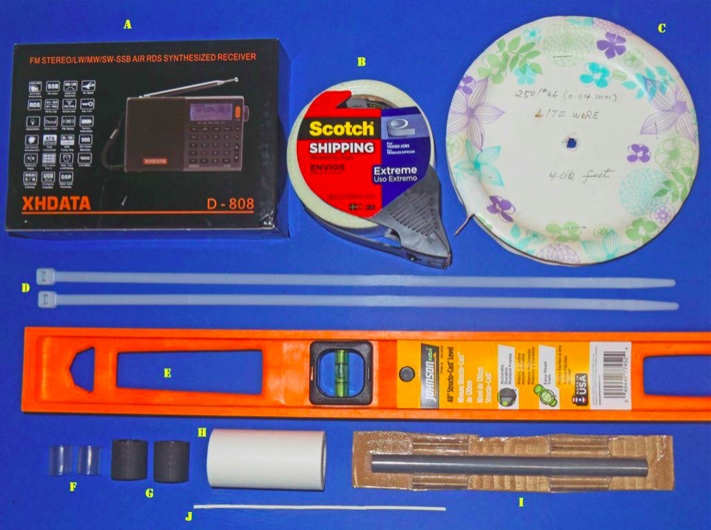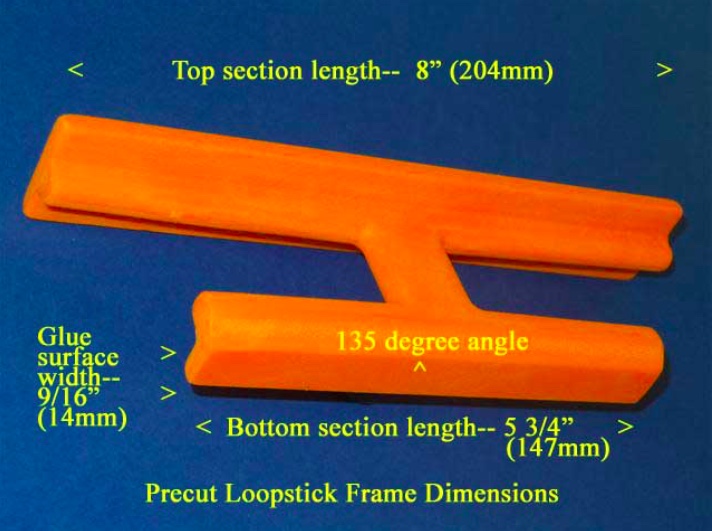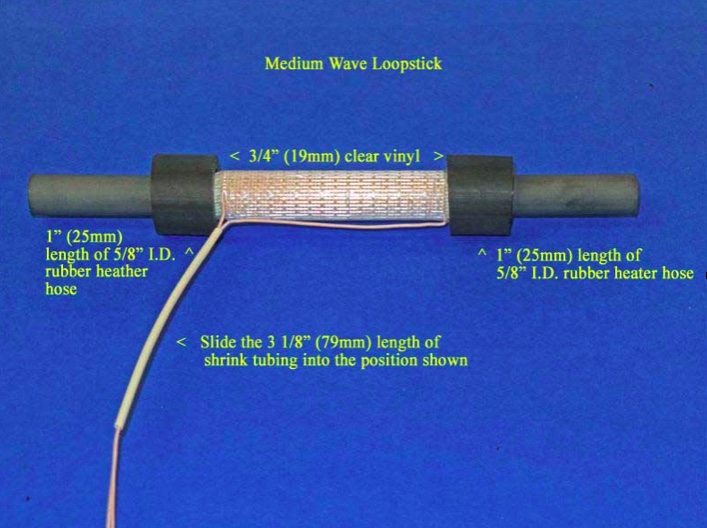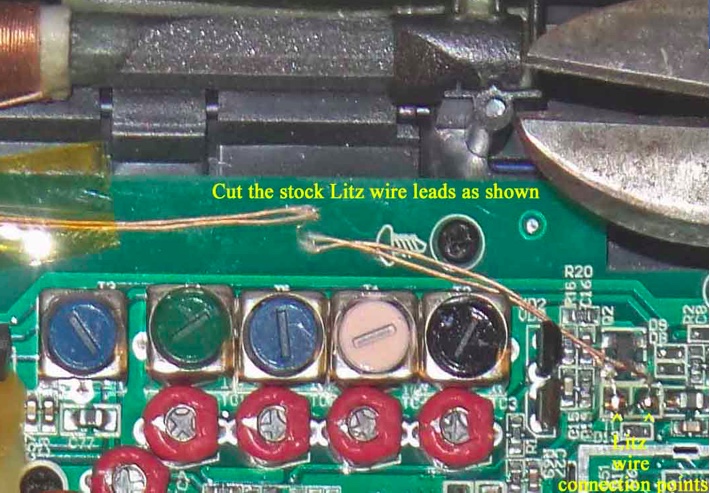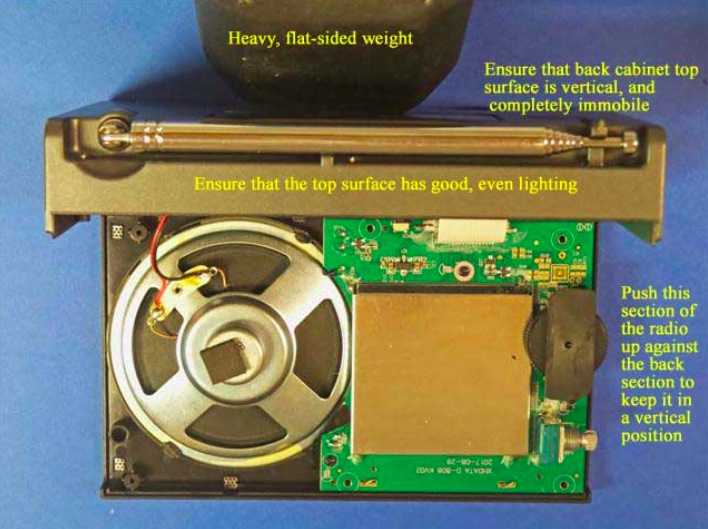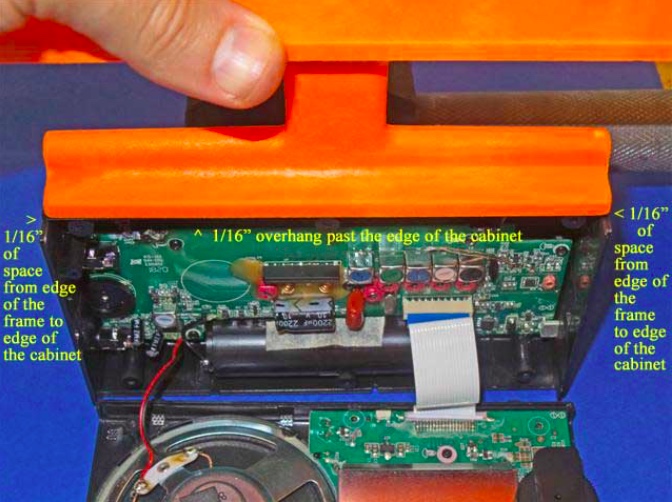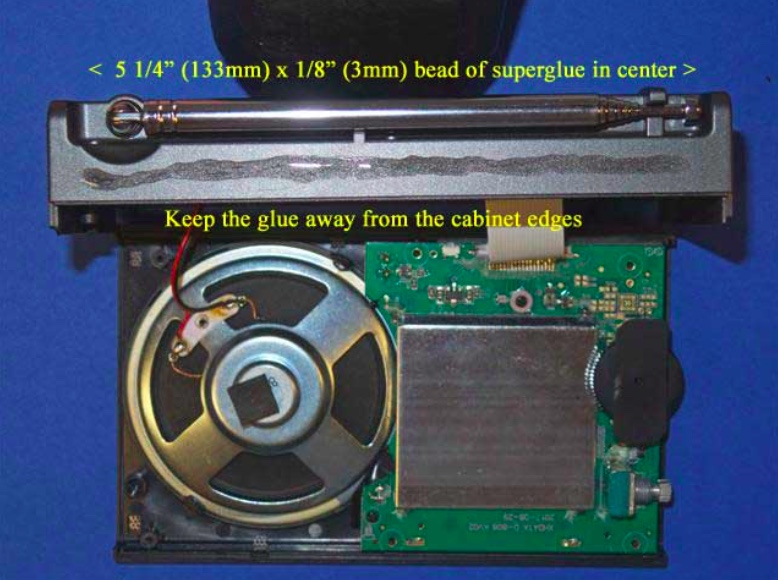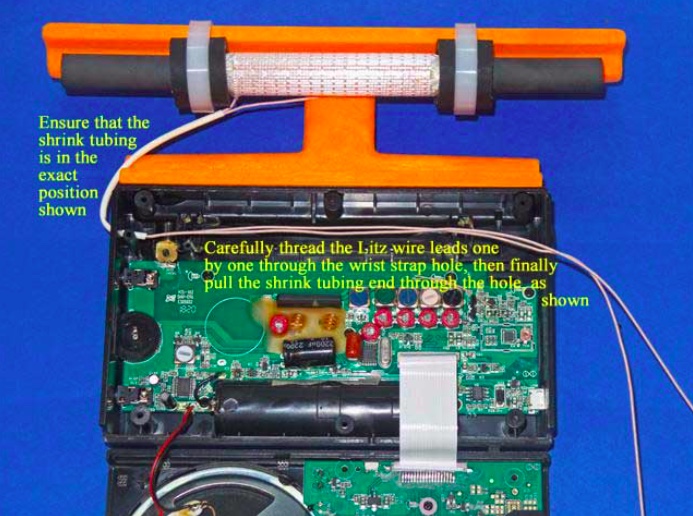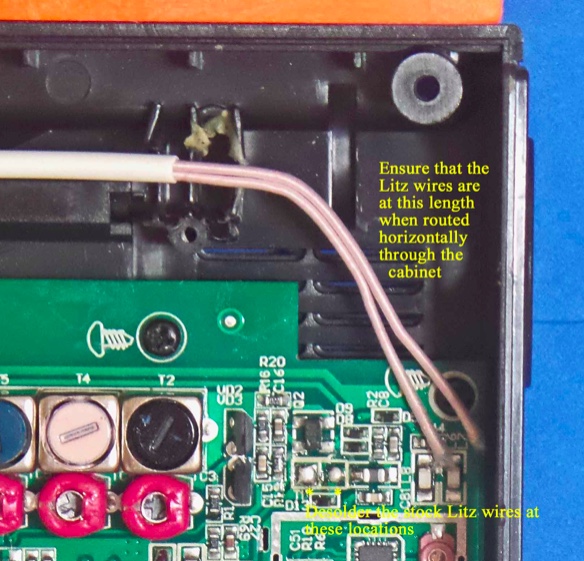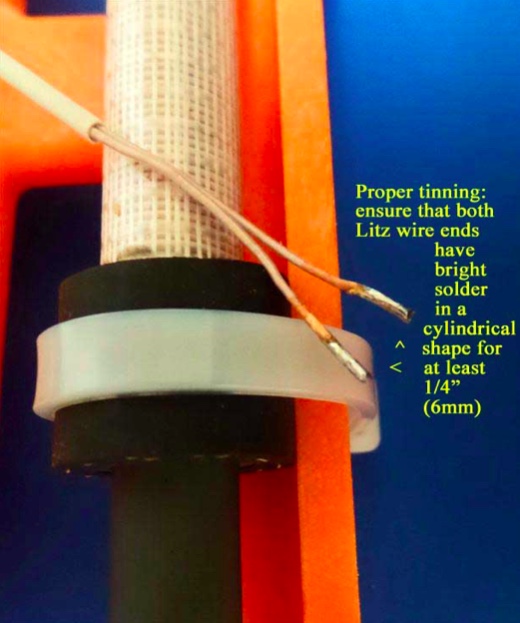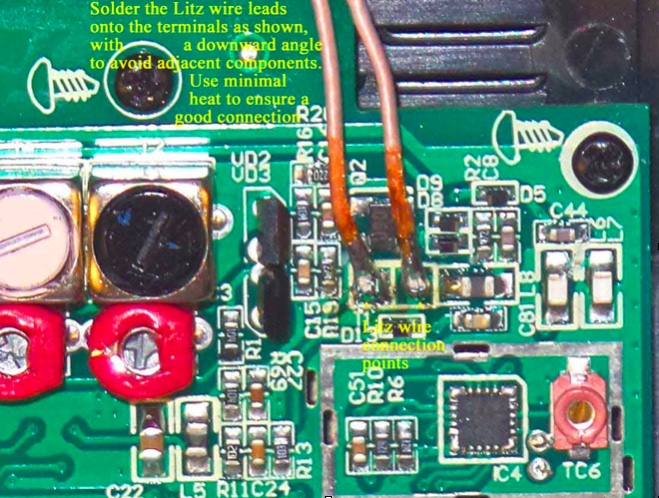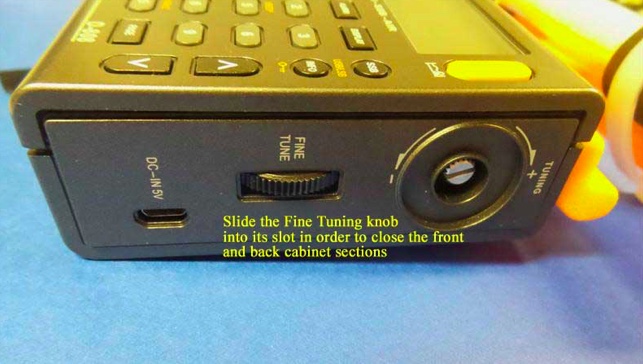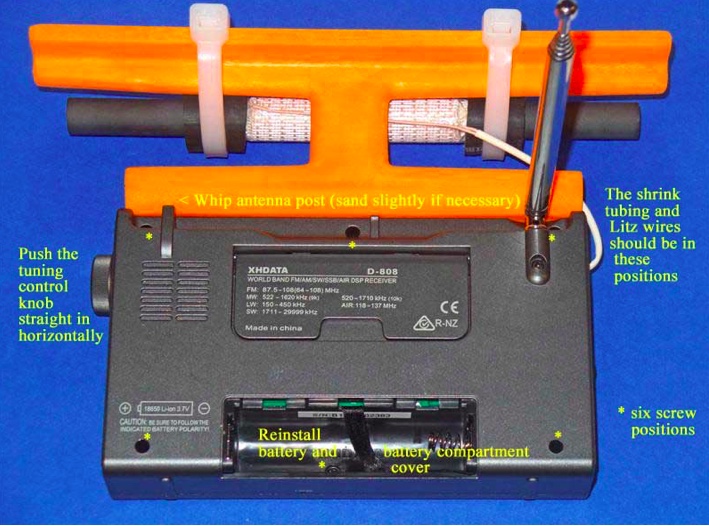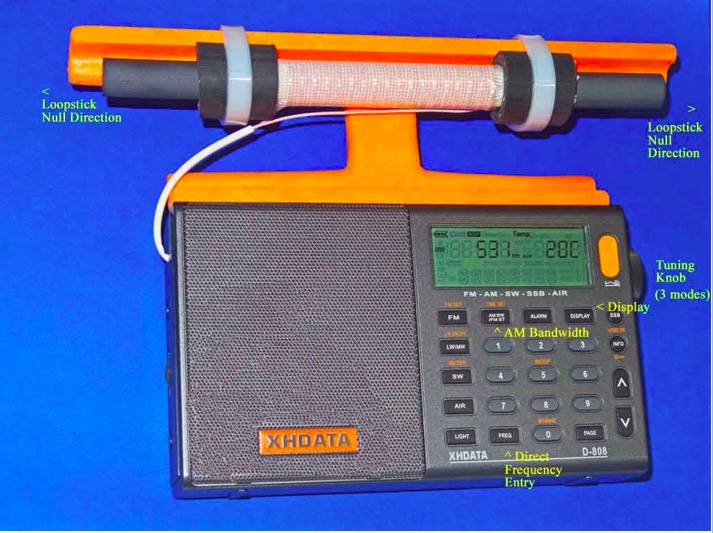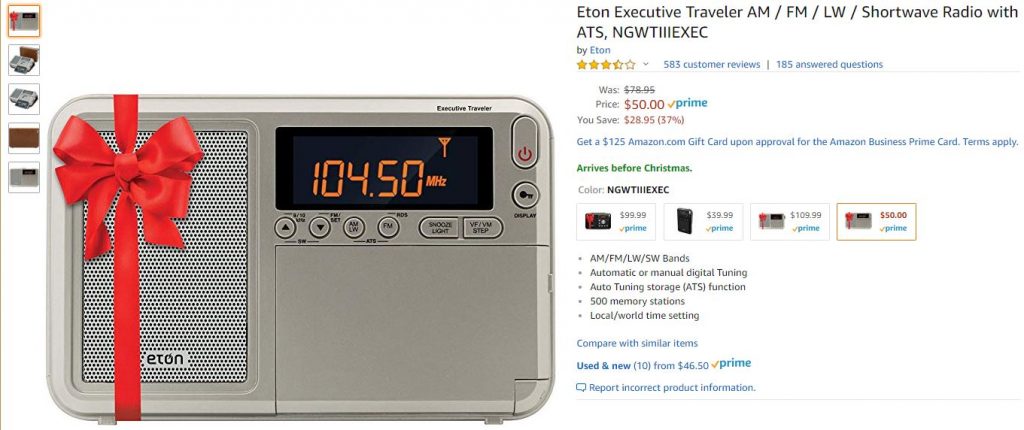 For those readers who like the Eton “Executive” trim level on their portables, I just noted that Amazon.com has lowered the price of the Executive Traveler to $50 US shipped. For how long? You never know with Amazon, but this is one of the best prices I’ve seen on the Executive Traveler. I gave my Traveler to a friend a couple years ago and now am very tempted to grab the Executive model mostly because I love the built-in case.
For those readers who like the Eton “Executive” trim level on their portables, I just noted that Amazon.com has lowered the price of the Executive Traveler to $50 US shipped. For how long? You never know with Amazon, but this is one of the best prices I’ve seen on the Executive Traveler. I gave my Traveler to a friend a couple years ago and now am very tempted to grab the Executive model mostly because I love the built-in case.
Category Archives: Portable Radio
Radio Deal: Eton Traveller III $48.53 shipped
Many thanks to SWLing Post contributor, Christian, who shares yet another Eton deal:
Hi Thomas. Thought your readers might like to know that the Eton Traveller III is on sale at Amazon for $48.53 shipped. This isn’t the lowest price I’ve seen for the III but it’s one of the lower ones so certainly a great deal. I have one and think it’s a great little portable set. I appreciate the little door on the front of the radio that protects some of the controls. When I throw it in a bag there’s less worry. Designed for traveling. Recommend!
Thanks, Christian! I agree that the Traveller III is a great little radio. I gave mine to a friend only because I have so many other similar portables. He travels a lot and I knew it would make for a nice companion. It also has brilliant audio for such a small portable. Certainly a great stocking stuffer to consider at this time of year!
Click here to view the Traveller III on Amazon.com (affiliate link).
Best of the best: Reviews of some of my favorite portable shortwave radios
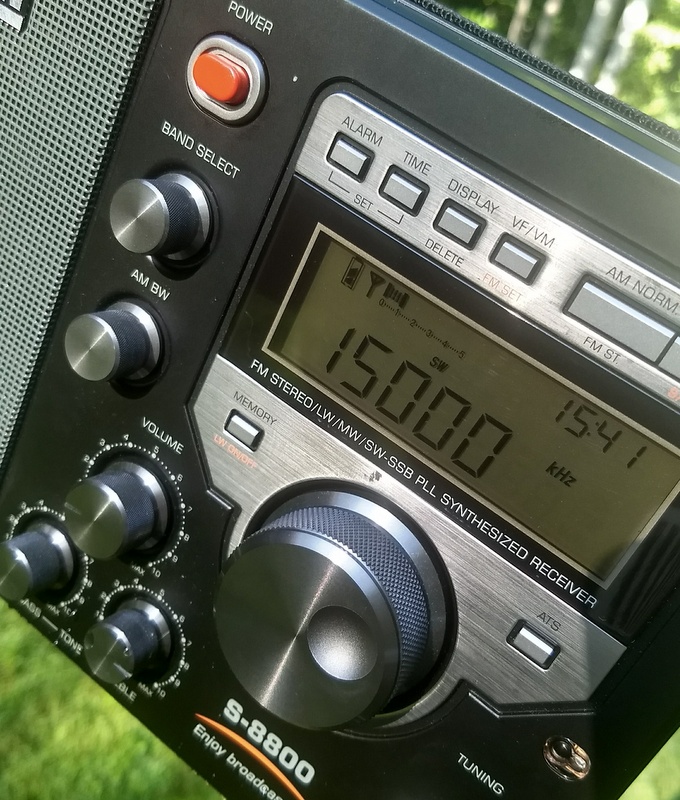 The following article originally appeared in the November 2018 issue of The Spectrum Monitor magazine:
The following article originally appeared in the November 2018 issue of The Spectrum Monitor magazine:
Shortwave Portables: Some of my favorites
Being a radio writer and blogger, I’m often asked, “Isn’t radio dying?” or “How long are you going to keep listening to radio when there are so many other options out there?”
My answer? It’s simple:
Radio is about the journey. And radios are the vehicles with which I explore our planet, albeit sonically. I’ll stop listening to radio when it stops transporting me to far-flung, fascinating places across our planet.
I’ll stop listening to radio when when it can no longer provide the kind of direct information and understated entertainment that is, for me (and a few others like me), a welcome relief from the overwhelming demands and distractions of the Internet.
And I’m perhaps a bit anachronistic in that I prefer radio’s subtler theatre of the mind over the mindless image consumption that television demands; thus, I’ll stop listening to radio when it too, tells me what I must think, what I must imagine, and what I must feel.
In short, radio is my tool for exploration, and I continue to enjoy tuning, listening, logging and learning from it. Very fortunately, I have the great pleasure of being in the middle of the world of radio technology in my reviews, evaluations, and alpha/beta testing.
This is why, over the years, I’ve made an effort to share some of my picks of the litter with others. So when TSM editor Ken Rietz asked if I would be interested in writing a feature about this, how could I resist?
What follows is a series of mini-reviews which focus primarily on the portable radio market. This is, by definition, a curated list, but I’ve done my best to include a variety of receivers I regularly recommend. The radios are listed roughly from least expensive ($25) to most expensive ($270), and I’ve only included models that are in production at the time of this publication.
Ever-popular portables
Portables are truly the most popular category of radio among shortwave radio enthusiasts, and it’s no wonder why! Among their other virtues, modern portables can pack a lot of performance into an affordable package, they’re great for travelling, and their all-in-one nature makes shortwave listening accessible to virtually everyone.
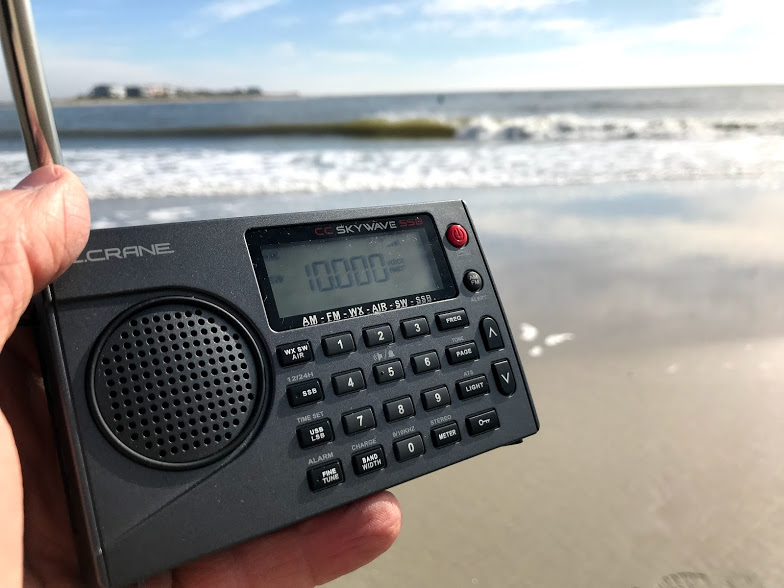 Since I’m in the constant stream of correspondence and comments from radio enthusiasts, I know another reason some listeners consider portables simply invaluable: portables give us refuge from noise. Since many of us live in, and/or travel to, busy urban areas filled with radio interference, portables give us a means to head to the park, beach, or the countryside to escape the noise and increase our odds of working DX.
Since I’m in the constant stream of correspondence and comments from radio enthusiasts, I know another reason some listeners consider portables simply invaluable: portables give us refuge from noise. Since many of us live in, and/or travel to, busy urban areas filled with radio interference, portables give us a means to head to the park, beach, or the countryside to escape the noise and increase our odds of working DX.
Fortunately for us, modern portables pack features of which, in former radio-listening days, we could have only dreamed.
What follows is a list of my favorite portables, listed by price in US dollars, with the least expensive first. Please note that retailer links include Amazon and eBay affiliate links that support the SWLing Post with your purchase.
Best Portable Shortwave Radios
$25 – $50 Range
Tivdio V-115 / Retekess V115 / Audiomax SRW-710S
Pros: Affordability, sensitivity, built-in recording and audio playback features, compact size, impressive audio from internal speaker
Cons: Mutes between frequencies, front panel buttons feel rather cheap, no SSB mode, sluggish response from controls, small telescoping whip
Summary: For about $25, it’s hard to complain about the V-115. Its performance and list of features exceeds expectations for radios in this price range, which are generally a disappointment. As for myself, I mainly use the V-115 as receiver to make off-air recordings and as an occasional backup radio. Unless your budget is very tight, don’t buy the V-115 as your main receiver; rather, buy it to keep in the glove compartment of your car or in your go-bag. Note that this radio carries a number of brand names and has been rebadged many times. Click here to read more reviews of the V-115 on the SWLing Post.
Retailers:
Grundig Mini
Pros: Compact, simple, adequate sensitivity and selectivity, clear backlight display, surprisingly decent audio from internal speaker
Cons: No direct frequency entry, no SSB mode, limited features compared with pricier receivers
Summary: The Grundig/Eton Mini is the latest in the lineage of the Mini series from Eton. The Mini has remained a popular radio because it delivers decent performance, with above average audio and makes for a nice broadcast listening companion. I recommend the Mini as a gift for those who want a simple pocket radio to operate with an easy-to-read display––great for the traveler or for elderly parents or grandparents who don’t like too many fussy buttons. Certainly a great value for the money.
Retailers:
Tecsun PL-380
Pros: Excellent sensitivity and selectivity, excellent audio via headphones, multiple AM bandwidths, ETM auto-tuning, excellent ergonomics, responsive controls, direct frequency entry, excellent bang-for-buck
Cons: No SSB mode, slight muting between frequency changes
Summary: The venerable PL-380 was my first ultralight Tecsun radio. It’s been on the market for many years, no doubt due to its solid performance. The PL-380 has an excellent receiver with impressive sensitivity and selectivity. The ETM auto-tuning feature is ideal for those of us who like to travel. The PL-380 is durable, affordable, and in terms of performance, is very similar to the PL-310ET (below). The PL-310ET might have a slight edge in terms of sensitivity. But for just $45, you simply can’t go wrong with the PL-380.
Retailers:
Tecsun PL-310ET
Pros: Excellent sensitivity and selectivity (perhaps slightly more sensitive than similarly-priced PL-380), excellent audio via headphones, multiple AM bandwidths, ETM auto-tuning, excellent ergonomics, responsive controls, direct frequency entry, excellent bang-for-buck
Cons: No SSB mode, slight muting between frequency changes
Summary: The PL-310ET, like its cousin the PL-380, is a classic ultralight radio and performs brilliantly for the price. The PL-310ET has long been the backup radio I’ve taken along on mini DXpeditions and field-listening sessions. The ETM auto-tuning feature is ideal for those of us who like to travel. The PL-310ET is reliable, and you’re hard-pressed to find a better performer under $50––indeed, it rivals some receivers twice its price. A solid choice for the budget-minded radio enthusiast and Ultralight DXer.
Retailers:
$50 – $100 Range
XHDATA D-808
Pros: Impressive overall performance, SSB mode, multiple AM and SSB filter widths, above-average audio from internal speaker, RDS, dedicated fine-tuning control, decent battery life from four standard AA cells, includes AIR band
Cons: Mutes between frequency changes, sluggish response from controls
Summary: The XHDATA D-808 was, no doubt, the most surprising receiver to hit the market in 2017. It’s an impressively sensitive radio across the bands, and can be snagged for an affordable price (generally $75-80 US). I was very skeptical of the D-808, but when I put it on the air, I discovered it gave some of my full-featured portables a run for their money. It is, indeed, a budget workhorse. If you live in New Zealand or Australia, you might find the very similar Digitech AR-1780 a more accessible option. Internally, the D-808 and Digitech AR-1780 (see below) are very similar. Click here to read more D-808 reviews on the SWLing Post.
Retailers:
Eton Field BT
Pros: Impressive sensitivity, excellent audio fidelity, can be used as a Bluetooth speaker, intuitive display, dedicated RF gain, simple tactile controls, overall quality feel
Cons: Clunky/quirky tuning is painfully slow, no direct frequency keying, no SSB mode
Summary: Last year, my friend Troy Riedel and I met at Mount Mitchell State Park to compare the Eton Field BT with the benchmark ($270) Tecsun S-8800. We were impressed that the Field BT did an admirable job competing with the S-8800 (see below). Indeed, due to the Field BT’s excellent audio, some broadcasts were slightly more intelligible than on the S-8800 (noting the S-8800 also has excellent audio). The only negative that was quite obvious at the time was how cumbersome it was to tune the Field BT compared with the S-8800. One year ago, the Field BT was widely available for $129––lately I’ve seen the price as low as $80 shipped. If you’re looking for a lunchbox radio that packs serious performance, room-filling robust audio, and you don’t mind slow tuning, the Eton Field BT is an excellent choice.
Retailers:
CountyComm GP5-SSB (a.k.a. Tecsun PL-365)
Pros: Excellent sensitivity, audio fidelity quite good via headphones, effective SSB mode, multiple AM and SSB bandwidths, very good medium-wave reception with supplied external bar antenna, unique form factor for one-handed operation, uses three standard AA batteries
Cons: No direct frequency entry, audio tinny via internal speaker, AGC doesn’t cope with fading as well as other comparable portables, no back stand nor rotatable whip antenna; thus this radio is not ideal for tabletop listening, supplied belt clip feels flimsy––if you plan to use this in the field, consider purchasing the excellent CountyComm GP5 series rugged case.
Summary: The GP5-SSB was one of the first sub-$100 DSP portables with SSB mode. Since its release others have entered the market (see XHDATA D-808 above for example). The GP5-SSB has a unique form factor tailored for handheld operation, much like a handie talkie. I keep a GP5-SSB in my backpack to use while on hikes, and am always very pleased with its performance. If you’re looking for a bedside or tabletop portable, I would recommend other similarly-priced receivers like the XHDATA D-808 or Digitech AR-1780. Note that if you live outside North America, you might find it easier to purchase the Tecsun PL-365 which is identical to the GP5-SSB. Click here to read our full review of the CountyComm GP5-SSB.
Retailers:
C. Crane CC Skywave
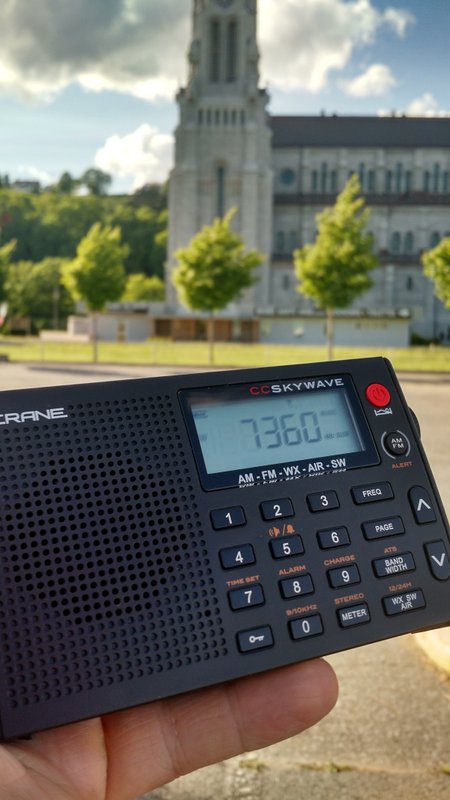
Listening to the 2016 BBC Midwinter Broadcast to Antarctica while traveling in Canada with the CC Skywave.
Pros: Overall great sensitivity and selectivity for a portable in this price class, considerate design, well-tailored for the traveler, AIR band is truly functional, NOAA Weather radio reception excellent, includes soft silicone earphones (in-ear type) actually worthy of AM/SW listening, auto scanning with the up/down buttons is very rapid, uses common micro USB port for power/charging
Cons: No SSB mode, internal speaker audio is somewhat tinny (use of the voice audio filter helps), no external antenna jack, mutes between frequency changes
Summary: I think the original CC Skywave is a brilliant little radio. Although it lacks SSB mode, it’s a fine broadcast receiver and one of the most sensitive travel portables on the market. For those of us living and traveling in North America, the CC Skywave is a veritable “Swiss Army Knife” receiver, as it not only covers AM, FM and shortwave, but is a capable AIR band and incredibly adept NOAA/Environment Canada weather radio receiver. At $90, I believe it’s the best radio value in the C. Crane product line. If the lack of SSB mode is a deal-breaker for you, consider the Skywave’s pricier brother, the CC Skywave SSB (below), also an excellent performer. Click here to read our full review of the CC Skywave.
Retailers:
$100 – 200 Range
Digitech AR-1780
Pros: Impressive overall performance, SSB mode, multiple AM and SSB filter widths, above-average audio from internal speaker, RDS, dedicated fine-tuning control, decent on-air battery life from four standard AA cells, includes AIR band
Cons: Mutes between frequency changes, sluggish response from controls. Note that at least one user has reported quick battery discharge when the radio is turned off. This has not been the case with my unit–in fact, it’s often turned off for a couple months at a time and maintains a steady, healthy charge.
Summary: Digitech is not a brand known for delivering enthusiast-grade receivers to the Australian/New Zealand markets through retailer Jaycar.. While they’ve a number of portables on the market, so many are plagued with internal noise and quirky controls. The AR-1780 is an exception. For $129.00 AUD (roughly $103 USD), you’re getting a full-featured radio that is, by and large, a pleasure to operate. The AR-1780 has its quirks, but so do so many ultra-compact portables in this price bracket. As mentioned in the cons above, there have been reports of some units draining batteries rather quickly when turned off (essentially in standby)––I have not experienced this, but this issue has been reported by a number of AR-1780 owners. The AR-1780 is certainly worth considering if you live in Australia or New Zealand. Note that the Digitech AR1780 and previously mentioned XHDATA D-808 share a nearly identical receiver design although their outer dimensions are slightly different. Click here to read our full review of the Digitech AR-1780.
Retailers:
- Jaycar (Australia and NewZealand–click here for more info)
- eBay.com
Tecsun PL-660
Pros: Smooth digital tuning with no muting between frequencies, excellent synchronous detector, functional SSB mode, direct frequency entry via keypad, brilliant ergonomics, excellent sensitivity and selectivity (a best-in-class!), excellent price point and value for benchmark portable performance
Cons: BFO knob instead instead of push-button SSB, only two filters (wide/narrow), lacks a line-out jack
Summary: I’ve owned a PL-660 since 2011 and still take it on DXpeditions and to use as a benchmark when evaluating new receivers. It has rock-solid performance all around with pleasant audio from the built-in speaker, and one of the best synchronous detectors on the portables market. The PL-660 is the radio I’ve recommended more than any other for newcomers to the hobby: it’s a very capable DX machine with an ergonomic, intuitive interface. Click here to read other SWLing Post reviews that include the PL-660.
Retailers:
Tecsun PL-680
Pros: Excellent sensitivity and selectivity on the shortwave bands, improved weak signal stability over the PL-660, stable sync lock, proven form factor with good overall ergonomics, great internal speaker––an improvement over the PL-660, but not as good as the PL-880––in short, other than medium-wave performance (see con), a worthy replacement for the PL-660; also sports excellent audio from the PL-680 internal speaker: improved over the PL-660, but not matching the fidelity of the PL-880
Cons: Medium-wave performance is lackluster, marginal noise floor increase on the shortwave bands (compared with the PL-660), lacks a line-out jack, SSB frequency display on my unit is + 1 kHz, so slight BFO adjustment is needed
Summary: If you’re a shortwave radio listener, you’ll be pleased with the Tecsun PL-680. In all of my comparison tests between the Tecsun PL-660 and Tecsun PL-680, the PL-680 tends to edge out the PL-660 performance-wise. This coincides with blind user surveys I conducted on the SWLing Post. If you’re a medium-wave DXer, you might skip over the PL-680; the PL-660 is likely a better choice for you. If you’re a casual medium-wave listener on the other hand, you’ll probably be pleased with the PL-680. Click here to read our full review of the PL-680.
Retailers:
CC Skywave SSB
Pros: Considerate design and ergonomics, well-tailored for the traveler, excellent sensitivity and selectivity for a compact radio, faster AIR scanning compared with the original CC Skywave, better HF frequency coverage than the original Skywave (1.711-29.999 MHz, compared to 2.300-26.100 MHz), pleasant SSB audio, multiple bandwidths in both AM and SSB modes, no overloading noted, well-written operation manual, excellent weather band reception, nice red LED indication lamps for SSB and Fine Tune engagement, NOAA Weather radio reception excellent, includes soft silicone earphones (in-ear type) actually worthy of AM/SW listening, uses common micro USB port for power/charging, excellent battery life from two AA cells
Cons: At $169, US the CC Skywave SSB is certainly the priciest compact portable on the market, yet mutes between frequencies, engaging SSB mode requires 2-3 seconds of delay (common for this DSP chip), no RDS, no audio-out jack, no sync detector (a “con” in this price class), no long-wave reception, first production run had some quirks which have now been addressed by C. Crane (in case you shop for a used unit).
Summary: I love the CC Skywave SSB. Sure, I wish it had RDS, an audio-out jack, didn’t mute between frequencies, and was less expensive (the current price of $169 seems excessive). But overall, it’s a fantastic package. I’m impressed with the amount of performance the Skywave SSB provides with such a short telescoping antenna. Since first being introduced to the Skywave SSB last year, it has become my choice travel portable. Check out our initial review of the CC Skywave SSB and the important updated second production run review.
Retailers:
Tecsun PL-880
Pros: Excellent ergonomics, excellent sensitivity and selectivity, superb audio from internal speaker, wide array of filter options in both AM/SSB more than on any sub-$200 portable on the market!), absolutely no muting between frequencies even while using a .5 kHz filter in SSB, sturdy carrying case has dedicated pocket for English operation manual, single supplied rechargeable battery delivers a very long life
Cons: Two-second delay when changing modes (AM/SSB/AM sync), some audio splatter on peaks in weak signal DX, sync detector (hidden feature) delivers mediocre performance and substantially reduced audio fidelity, AM (medium wave) prone to imaging if strong AM broadcasters are nearby, supplied rechargeable battery is not as common as AA batteries
Summary: I’ve owned the Tecsun PL-880 for five years and it continues to impress. Tecsun has made iterative changes to the firmware over time, and now this radio is one of the best performers in the sub-$200 price bracket. The audio from the PL-880 internal speaker is simply unsurpassed in this size of radio. The PL-880 isn’t perfect, but it does an amazing job, pleasing DXers from every angle and even ham radio operators who appreciate the narrow filter settings in SSB mode. All in all, you can’t go wrong with the PL-880––it’s certainly a quality piece of radio kit! Click here to read our full review of the PL-880. Click here to read our list of PL-880 hidden features.
Retailers:
Eton (Grundig Edition) Executive Satellit
Pros: Excellent sensitivity, excellent audio from built-in speaker, ergonomic and intuitive interface, uses common AA batteries, multi-joint swivel antenna is best in class, excellent build quality, display is easy to read, effective station memory management
Cons: Mutes between frequencies, executive Satellit model typically costs more than previous non-executive model
Summary: The Satellit has a dedicated following among hard-core DXers, both the audio and superb sensitivity placing it well within the realm of benchmark receivers. It’s a fantastic field radio and feels like one that should serve you over the long haul. It’s not a perfect radio; I especially wish it didn’t mute between frequency changes, although Eton seem to have minimized this in the latest production runs. If you’re seeking a super-sensitive portable to sniff out weak DX, then the Satellit is worth serious consideration. Check out some of Oxford Shortwave’s previous posts which include the Executive Satellit.
Retailers:
$200+ Range
Tecsun S-8800
Pros: Brilliant audio fidelity from built-in speaker, dedicated AM bandwidth and fine tuning controls, excellent bespoke IR remote control, capable SSB mode, excellent shortwave sensitivity, excellent shortwave selectivity, excellent FM performance, easy-to-read backlit LCD digital display, remote control beautifully equipped for full radio functionality, included 18650 rechargeable lithium batteries power this radio for hours, BNC connection for external antennas, does not overload even when connected to large external antennas
Cons: Lackluster mediumwave performance, no synchronous detector, no direct keypad entry (pro: remote control, however, has excellent keypad entry), can’t charge and listen at the same time as is not designed for AC operation, no backstand, when in narrowest SSB filters AGC can’t reliably handle audio/signal changes, slight “warbling” sound while using fine-tuning control in SSB mode, no RDS display on the FM band
Summary: If your primary use of the S-8800 is for medium-wave or long-wave DXing, you should look elsewhere. While the S-8800 will serve you well with local AM stations, it will not dig signals out of the noise like other better-equipped AM receivers. But: if you’re primarily a shortwave radio listener, you’ll certainly be pleased with the S-8800! The S-8800 consistently outperforms my beloved Sony ICF-SW7600GR and my Tecsun PL-880. Indeed, it is the most sensitive and selective shortwave portable I own. On the flip side, it’s also the most expensive: $268 at time of publication. If you want top-class HF performance from a portable radio and you expect superb audio, I think you’ll find the S-8800 well worth your investment. Click the following links to read our full review of the S-8800, 13dka’s review which compares the S-8800 with the PL-660 and D-808 and Dan Robinson’s most recent S-8800 comparative review.
Retailers:
There’s a portable for everyone
You might have noticed that there’s a portable receiver on this list for everyone:
- The listener who wants turn-on-and-play functionality
- The casual listener
- The hiker
- The traveler
- The DXer
- The ham radio operator
Keep in mind that this is a curated list of some of my favorites that are widely available on the market new. There are a number of receivers on the market––the Degen DE1103 comes to mind––which would have made it to this list had they not been “updated” with a DSP chip. Manufacturers add DSP to reliable models in order to increase profit margin, since DSP chips cost a fraction of traditional receiver design. DSP chips have revolutionized the portable market in many positive ways, but if they’re not properly implemented in a set, they can produce higher noise floors, audio anomalies, shaky AGC, and other undesirable traits. The DSP receivers in the list above have properly implemented DSP technology and, save the cheapest models, are all what I would consider “enthusiast grade” radios.
What about other types of radios?
Of course, if you’ve become addicted to radio, you shouldn’t stop at portables! I would encourage you to check out the three-part Software Defined Radio Primer published in September (Part 1), October (Part 2), and November (Part 3). The SDRs I mention in the primer are essentially what I consider the best of the best.
Of course, there are still a handful of tabletop shortwave receivers like the Alinco DX-R8T HF receiver, the Elad FDM-DUOr SDR receiver, and the Icom IC-R8600 wideband receiver. All are top-notch performers and, when paired with an effective antenna, can pull out weak signals much better than a portable radio ever could.
If you’re a ham radio operator, take advantage of modern general-coverage transceivers. Only a couple decades ago, most transceivers were “ham band only” and the ones that were not compromised performance if they included the broadcast bands. This is no longer the case. Modern general coverage HF transceivers can rival dedicated tabletop receivers in many cases. I’m particularly fond of the Icom IC-7300, IC-7200, and Kenwood TS-590SG as home stations, and the Yaesu FT-818, Elecraft KX3, and the Elecraft KX2. This is a mere sampling of some of the excellent general-coverage transceivers on the market. Before you purchase a general-coverage transceiver, simply make sure it has AM mode and that the bandwidth is wide enough for pleasant audio. Ask current owners how their transceiver sounds on the broadcast bands.
In summary
As you select your next radio, take into consideration how and where you plan to use it, as well as what you’re willing to spend. The good news is, we live in an era with an extraordinary number of options covering all price ranges and uses. So, be assured: there’s a radio out there just waiting to sonically transport you to far-flung and fascinating regions, too.
Vive la radio! Long live radio!
Do you enjoy the SWLing Post?
Please consider supporting us via Patreon or our Coffee Fund!
Your support makes articles like this one possible. Thank you!
Radio Deals: Grundig Executive Satellit on sale $109.99 shipped
Many thanks to SWLing Post contributor, Gregg Griffith, who notes that the Eton Grundig Edition Executive Sattelit is on sale at Amazon for $109.99 shipped. This is the lowest price I’ve ever seen for a new GEE Satellit. Since this is an Amazon sale, the price could change at any time. I have the original Satellit and am mighty tempted to grab this one.
Click here to view on Amazon (affiliate link).
FYI: This is a choice portable for DXers–check out some of Oxford Shortwave’s previous posts.
Dan compares and reviews the Tecsun S-8800 portable AM/FM/shortwave receiver
Many thanks to SWLing Post contributor, Dan Robinson, for the following guest post and review:
Tecsun’s S-8800: Is This All The Radio You Will Ever Need?
These days, we who still derive enjoyment from listening to shortwave broadcasts, be they larger international broadcasters or smaller stations that remain on the air against all odds in the Internet age, also enjoy using the many types of radio receivers that enable this activity.
One of the cruel ironies is that today’s technological advances have made possible the kind of worldband radios (the term that first came into wide use way back in the 1980’s) that years ago we could only dream of, be they full communications receivers or portable receivers.
Having begun my own DXing/SWL career in the late 1960’s, and pretty much maintained my hobby activities over the decades, I have used pretty much every receiver that ever existed, from tube radios to today’s latest DSP wonders.
I have a soft spot for classics from SONY — my list of portables today includes the fantastic SONY ICF-SW77, SW-07, SW-55s and SW-100. Panasonic is represented in my portable collection by the wonderful RF-B65.
Only in recent years did I decide to test the main higher end portable offerings from Tecsun: the PL-660/680, and PL-880. What I discovered, as have most people who own the Tecsuns, and similar receivers such as the XHDATA D-808, are the wonders of DSP chips and the great flexibility they provide, such as multiple selectivity options, along with excellent sensitivity.
Though it’s been on the market for going on three years now, one of the receivers I had not been able to test was the Tecsun S-8800. There are quite a few reviews already online. Some go into extensive detail in describing the plus and minus points of the radio.
With so many people having already assessed the radio — and most of them in fairly glowing terms — I won’t repeat a long list of technical specs, as you can find those in other reviews, and on the site of Hong Kong-based Anon-co, which is probably the main seller of the S-8800.
Headline
The S-8800 is arguably the best multi band radio portable among portable category offerings on the market today. It combines superior audio delivered from its superb front-firing speaker, with equally superb sensitivity (triple conversion), and multiple selectivity options, with an amazingly professionally-executed remote control.
I used the S-8800 in a number of physical locations, from public parks where I hoped to avoid high noise levels, to my back yard where noise levels are, unfortunately, quite high. I have compared the S-8800 to a number of portables in my collection, including: SONY ICF-2010, SW-77, SW-55, along with Tecsun’s 660 and 880, Grundig SAT-500.
Audio
Hands down, the S-8800 wins the audio competition when compared to pretty much every other radio. Where the competition gets tight is with receivers such as the classic Grundig Satellit 500, and Tecsun’s PL-880.
Sensitivity
This is a TRIPLE conversion radio. As everyone knows by now, Tecsun did not merely adopt the cabinet of the old Eton S350 but basically stuffed a hot rod racer into the cabinet of what was previously a mediocre radio at best.
Selectivity
Widely used in a number of radios these days, the S-8800 uses a DSP chip that is seen in a number of other receivers. The best description I have seen so far is in the review by Jay Allen who notes that Tecsun “decided to utilize a combination of DSP (Digital Signal Processing) circuits along with traditional analog circuits . . .most of the AM/SW circuitry is PLL/analog along with the 1st and 2nd IF’s, while the 3rd IF is DSP.” It appears that after a bit of a rocky period in the beginning when initial units suffered from images and birdies, Tecsun got it right.
Ergonomics
Much has been said about the fact that Tecsun decided not to include a keypad on the radio itself. I too was skeptical. We have all become accustomed to keypads as standard equipment on portables.
Personally, I do a lot of my listening on the beach during vacations, and am used to being able to hold and operate the radio in such situations, so the thought of having to carry a remote control seemed uncomfortable at best.
However, the reality is that it’s still possible to navigate the shortwave, AM, and FM bands easily even without the remote — call me old fashioned, but I am from a group of older listeners who have most frequencies memorized anyway, so I know where I want to go to hear certain stations.
Tecsun hit it out the ballpark with the remote supplied with the S-8800. It looks like something you would find with high end stereo equipment and clearly much thought went into making sure it can control every aspect of the receiver, from SW band slewing to selectivity, volume, readout — everything except BASS and TREBLE control, Timer/Alarm, and master volume (i.e. as other reviewers note, you have to set the on-radio master volume to a high enough level first, then use the remote to vary).
Power
The radio requires two 18650 lithium (Li-ion) rechargeable batteries, with individual indicator LEDS inside the battery compartment. This choice is perhaps one of the most controversial aspects of the 8800. Among other things, 18650s usually receive more attention from airport security personnel if one is taking the radio on a trip — this is something everyone should keep in mind. Any radio being transported on a flight these days is going to be subjected to added scrutiny, simply because almost no one uses radios anymore.
As for the power needs of the receiver, the 18650s seem to do a good job and last quite a long time, even days. Included in the box is one of those white USB charger blocks — quite small and convenient. I usually travel with separate 18650 chargers, the kind used with high end flashlights, so having spare sets of charged batteries is not a problem. But if both 18650’s in the Tecsun are drained, the radio definitely needs to re-charge to a minimum level required for operation.
As I write this, I plugged the S-8800 into a wall outlet (a blue LED indicator on front indicates charging mode) and I was unable to use the radio as the battery level had completely zeroed out. Also keep in mind that the USB charging brick throws off EMI to other radios in the vicinity, and makes it impossible to use the S-8800 itself — there is just too much interference from the charging process to the radio’s receiving circuitry.
Comparisons
As mentioned, I compared the S-8800 with a number of other portables in my collection. Each of these other radios, including the classics from SONY such as the SW-55 or SW77 have their strengths. For example, the SW77 has the best implemented synchronous reception of any portable since the ICF-2010 along with superb sensitivity. However, even the large speaker on the SW-77 was unable to compete with the S-8800. Only radios such as the older Grundig SAT 500/700 had the advantage when compared to the S-8800’s speaker, with the Tecsun PL-8800 close behind.
Receiving Comparisons
I decided to take the S-8800 out to my back yard for a receiving comparison with the receiver I consider to be among the top five best in what I call the small portable category (which is above the mini-portable category in which we find the SONY SW-100 and SW-07 and similar size radios).
In intensive use over the years, I have concluded that the Panasonic RF-B65 is probably among the hottest small portables. With its famous amplified whip antenna, the 65 time after time succeeds in allowing me to hear stations that other portables struggle with (see this 3 radio comparison I posted a few years ago in which the B65 outguns the Sangean 909X and SONY SW-07).
Rather than produce several separate videos, I have combined one listening session comparing the S-8800 with the RF-B65. It’s a bit long, so my apologies, but gives you an idea of how these two fine portables did going head to head.
Click here to view on YouTube.
Leaving aside the obvious superiority of the Tecsun where audio is concerned, the S-8800 competes well with the Pan RF-B65, often superior to the smaller radio, but sometimes inferior in one respect.
While there was nothing the S-8800 could hear that the Panasonic could not, signals seem to jump out of the S-8800 in a way that they did not with the smaller radio. However, there appeared to be an interesting difference when it came to the ability of each radio to deal with interfering stations 5 kHz above or below.
As shown in the video, the Panasonic was able to distinguish more clearly between a station on 9,650 kHz (Guinea) and a station 5 kHz above (in this case, Algeria via France, using 9,655 kHz) than the Tecsun, which seemed to struggle. Indeed, at one point I was forced to attempt ECSS (Exalted Carrier SSB) mode to separate the two stations, whereas on the Panasonic, being the older and simpler radio design was an advantage in that the RF-B65 was actually able to more clearly separate the two stations by “de-tuning” from the center frequency.
One huge advantage of the S-8800 by the way is that there is a hidden software change that enables one to adjust SSB zero beat to zero or near zero. This means that in theory using LSB/USB to improve reception is possible, though keep in mind that there may be some variation from unit to unit. So far, after performing the so-called ‘secret’ fix (among a list of tweaks discovered so far) my particular S-8800 appears to be able to zero beat LSB/USB with little or no variation between the side bands, pretty much up and down the SW bands.
Conclusions
For me, the S-8800 has turned out to be the biggest surprise of the last several years. Coming seemingly out of nowhere, packaged in the cabinet of a receiver that was seen as mediocre at best, we have a triple conversion beauty (it seems to weigh almost nothing by the way) that provides pretty much every tool required these days to tackle what is left of shortwave broadcast reception. It has superior audio, unless one compares to older Grundig and similar sets.
Drawbacks are quite few to be honest. A case can definitely be made that using 18650 batteries was a poor choice by Tecsun. This means, for example, that if you’re out on the beach or elsewhere for many hours, the only way to charge up the radio would be to use a separate phone battery charger rather than simply be able to slip in regular alkalines. But then, I carry separate battery charge units already for my phone.
The big criticism that synchronous reception could have been included is also valid. The same was said about the SONY ICF-SW55 — with synchronous reception, and a bit more careful design of the tuning circuit, that radio could have been a heavier hitter, a mini-ICF 2010, something the much more expensive SW-77 was designed to improve upon.
However, so far radios utilizing DSP chips have struggled when it comes to synchronous reception capability. Indeed, the feature has ended up being discovered only as one of a number of ‘secret’ features. Only the PL-660 has a decent synchronous feature, but that radio is hobbled by limited selectivity options, while sync on the PL-880 is pretty much useless.
Finally, I have to say thank you to Tecsun for doing everything possible to avoid the dreaded ‘MUTING’ problem that has been seen on so many small portables.
As I found to my disappointment when using even the much-praised Eton Grundig Satellit, and even the C Crane Skywave SSB, this problem can be a killer for those of us who consider it absolutely critical to be able to hear EVERYTHING on and between frequencies.
So, the big question — would I recommend the S-8800? As with almost everything, the answer to that is, it depends on what kind of a listener you are, and expectations.
From a performance perspective, if you are like me, a die-hard DX’er at heart who gets a kick out of searching for the last Peruvians on the air, the S-8800 should be more than sufficient. If you’re both a die-hard DX’er and enjoy FM and AM, the 8800 should also be a perfect selection, since it’s been reviewed quite well in terms of medium wave and FM capability.
A personal note — for me, part of the fun of shortwave portables has been their ‘cool factor’. I’m just one of those who likes to carry around complicated looking radios with lots of buttons. The SONY 2010, SW-55, SW-77s, older Grundigs all fit the bill.
I never thought the S-8800 or radios similar to it in appearance would. So, for me it’s going to require a bit of a change, since the S-8800 looks like, well . . . it looks like a ‘toy radio’!
But it’s one hell of a toy-looking radio. It’s a triple conversion monster packed in the frame of something that, at one point in the past, you might have considered getting for your kids (if they even knew or know what a radio is!).
As many of us are at this point in our lives, I am also thinking ahead — to the day when my numerous premium Watkins Johnson and JRC radios, and a few boatanchors hanging around, will have to go because of downsizing.
When I’m 65, as the Beatles song goes — or more likely 85 or 90 — what will I be able to fit on a bedside dresser and use easily to tune in whatever is left on shortwave (if anything)?
The answer to that question is a radio that’s small enough and enough of a performer, preferably with a well-designed remote, to bring in anything that’s still on HF, MW, and FM. With those needs in mind, the answer is already here, in the Tecsun S-8800.
[I want to express sincere thanks to Anna at Anon-co who responded quickly when I proposed a review of the S-8800 and supplied the receiver on which this article is based. Anna was patient as my original plan to have a review in by September was delayed by unavoidable personal matters. Thanks also to Tom Witherspoon for getting the review up so quickly].
Click here to check out the Tecsun S-8800 at Anon-Co’s website and here via the Anon-Co eBay store.
Do you enjoy the SWLing Post?
Please consider supporting us via Patreon or our Coffee Fund!
Your support makes articles like this one possible. Thank you!
Updated and Original Versions of the CCRadio-EP Pro Briefly Compared
Remember the American television game show To Tell The Truth? This very long-running show challenged four celebrity guests and viewers to identify the real “central character” in the midst of two impostors.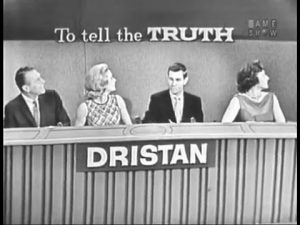 I was reminded of this game show when attempting to tell the difference between the original and recently updated versions of C. Crane’s CCRadio-EP Pro receiver when viewing the front panels. If there’s a difference, I can’t spot it! You need to turn around the radios to see the new EP-Pro’s key feature: switchable 9 kHz/10 kHz tuning steps.
I was reminded of this game show when attempting to tell the difference between the original and recently updated versions of C. Crane’s CCRadio-EP Pro receiver when viewing the front panels. If there’s a difference, I can’t spot it! You need to turn around the radios to see the new EP-Pro’s key feature: switchable 9 kHz/10 kHz tuning steps.
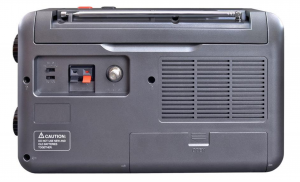
The only clue to the newest version of the CCRadio-EP Pro is the 9/10 kHz tuning switch on the back panel.
I recently met with a good friend and radio hobbyist from Oregon to compare a few selected portable radios, FSL (Ferrite Sleeve Loop) antennas, and the newest low-noise Wellbrook ALA100LN module that was introduced just a few weeks ago. I was particularly interested in a head-to-head match-up of my friend’s original EP-Pro versus my newly arrived EP-Pro (9 kHz/10 kHz steps) version.
I’m looking forward to Thomas’ usual thorough review of the new CCRadio-EP Pro, but I want to offer a few observations of medium wave tuning after my time with the two models:
- On very weak daytime MW signals, the radios are equally sensitive except on higher frequencies where the new model excels to a moderate degree. It’s enough of an advantage to make the difference between catching an ID or not on a low, DX-level signal.
- The new EP-Pro feels more accurate–and simply more enjoyable–to tune, thanks to the elimination of false “peaks” surrounding the main signal. This is a BIG plus for the new radio, and frankly the CCRadio-EP should have performed this way from the start. Kudos to C. Crane for correcting this problem, but I can understand why the original version was brought to market with the odd tuning quirk. It isn’t a deal breaker for most non-DXing purchasers.
- I could not find an instance of soft muting on either radio. I listened for a while to signals barely above the noise floor, and never did audio “cut in and out” suddenly, a clue to soft muting. Both receivers are very useful for chasing weak MW stations…but the new version is highly preferred for ease of tuning because of the lack of false audio peaks.
- With the tuning working way it should, medium wave channels “snap” in and out as you slowly tune. This took a little getting used to, but after a while I began to appreciate the sense of exactness with the newest CCRadio-EP Pro.
- Fast excursions up or down the band (either radio) will blank the audio, recovering when you stop tuning or slow down. I believe this is simply a case of exceeding the AGC’s recovery time, not soft muting. It’s easy to live with, but granted the effect is not one of smoothness as found on traditional, non-DSP analog receivers. Successful DXing takes a slower approach anyway when scanning the band; casual listeners may be more annoyed by either version of the radio if they are used to very quick knob-cranking.
- The Twin Coil Ferrite “AM Fine Tuning” control works well on both units, and gives significant gain to weak signals on either extremity of the band. I love this feature; it makes digging out the weak ones a lot more fun!
So, should you buy the newest CCRadio-EP Pro with the 9 kHz/10 kHz steps?
- If you already own a CCRadio-EP Pro and are fine with the false tuning peaks and have no desire for the 9 kHz MW step option–keep your radio! Only on high band does the new model have a sensitivity edge. Especially don’t make the jump if you’re a casual listener and listen only to a handful of local stations, or a single distant station.
- If you do not own a CCRadio-EP Pro yet, but are in the market, definitely buy the newest version. Be aware that you can only be assured of getting the newest model if you purchase directly from C. Crane. Amazon does not yet carry the newest version according to some reports.
- If you’re a radio junkie and just have to have both…go ahead…we understand!
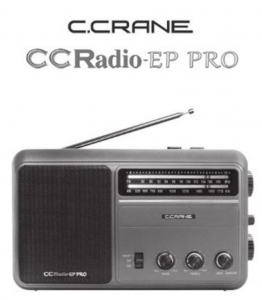
I also made a short video comparison of the new EP Pro versus the top-ranked Panasonic RF-2200 on medium wave:
https://www.youtube.com/watch?v=zbZ-06uBsNs
Guy Atkins is a Sr. Graphic Designer for T-Mobile and lives near Seattle, Washington. He’s a regular contributor to the SWLing Post.
Guest Post: Supercharging the XHDATA D-808 with a 7.5″ loopstick
Many thanks to SWLing Post contributor, Gary DeBock, for sharing the following guest post:
Supercharging the XHDATA D-808
Installation of High Performance AM and LW Loopsticks
By Gary DeBock, Puyallup, WA, USA, September 2018
Introduction
As a stock receiver the Chinese-made D-808 AM-LW-FM-SW-AIR portable is a very capable performer, with AM reception superior to that of any current Ultralight model, and impressive FM reception as well. The radio was certainly “inspired” (to use a generous term) by the C.Crane Skywave SSB model, which coincidentally was manufactured in the same part of China by C.Crane’s Redsun partner—with the first units going out the door a few months before the D-808 came into existence.
Because foreign intellectual property is routinely copied in China with no punishment from the government, XHDATA essentially had the chance to copy all the good points in the Skywave SSB design and improve upon its weak points as well. The only precaution that XHDATA took after this wholesale design appropriation was to forbid direct shipments of the D-808 from China to North America—presumably to avoid a copyright lawsuit by C.Crane. As such, the first D-808 models were sold to the rest of the world around January of 2018 at a price about half that of the Skywave SSB, while North American DXers were told that since the model couldn’t be shipped to the USA or Canada, they were out of luck.
Of course some D-808 models did make it into North America, where it was found to be a very capable portable with astonishing value for the price. Finally around March, an enterprising Chinese eBay seller came up with a plan to ship the model to North America through Israel, thereby skirting around XHDATA’s direct shipment prohibition. As of late August this eBay seller (harelan ecommerce) has already sold 62 of the D-808 models this way, even though he charges a premium for shipment to North America. Whether this single supply source will continue to serve North American customers is currently unknown, but out of the 7 models that I have purchased from him there hasn’t been a single D-808 model with any issues– despite the apparent lack of any manufacturer’s warranty offered on the radio.
Despite the D-808’s rather dubious design pedigree there is no doubt that the Chinese engineers (or reverse engineers?) did a superb job in creating an awesome radio for the money. Besides directly copying the Skywave’s SSB design and controls, XHDATA also made significant improvements, including a longer loopstick (providing clearly superior AM sensitivity), a much more powerful audio amplifier (correcting a serious shortcoming in the Skywave SSB) and a much lower price (about half that of the $169.99 Skywave SSB, for models shipped outside North America). Another great advantage for someone wishing to perform this loopstick upgrade are the perfectly located, highly accessible Litz wire connections on the RF circuit board—apparently used by the Chinese engineers to conveniently test out various loopsticks, and retained in the final product. The radio’s high quality construction and survivability in adverse conditions were proven repeatedly over the summer here, with the model surviving accidental exposure to a 104 degree (43 degrees C) car trunk temperature, exposure to moderate rain, repeated travel bumps, and use as the main receiver during a 9-day DXpedition to a plunging ocean side cliff in Oregon state. The 3.7v lithium-ion rechargeable battery provides superior run time for extended DXing sessions, and is included in the D-808 shipping package, along with a USB cord to charge the battery, a plug-in wire antenna (for FM,SW and AIR), a vinyl carrying case, and a pretty basic English instruction manual.
One thing you will NOT find supplied with the D-808 is a warranty card– either in the shipping box, or online. This is pretty standard practice in China, incidentally, where concepts like refunds and warranties aren’t generally part of customers’ expectations. This doesn’t necessarily mean that XHDATA won’t repair obvious problems in a new D-808, but it does mean that they aren’t assuming the obligation to do so. I have heard from one North American purchaser who received a new D-808 with a defective speaker, and he is still waiting for the model to be repaired (after paying the shipping charge to send it back to China). Each individual purchaser must decide whether or not this lack of any warranty is a deal breaker. But if you are looking for a final reason to perform this loopstick transplant, why not consider the fact that you will not be violating any manufacturer’s warranty by doing so??
Realistic Expectations
Although this 7.5” loopstick upgrade will certainly make your D-808 far more sensitive than the stock model on Medium Wave or Longwave, it is not designed to compete with large (2’ sided or larger) inductively coupled box loops, or any of the new FSL antennas. The sensitivity upgrade will boost the D-808’s MW band weak-signal performance up to the level of classic portables like the ICF-2010 and RF-2200; however, and since the D-808’s DSP-enhanced selectivity will generally exceed that offered by these classic portables, the overall DXing capability in the AM mode could be considered slightly greater. The D-808 does have SSB capability, although it lacks the SSB tuning convenience offered by the ICF-2010 and RF-2200. It also lacks the ICF-2010’s superb Synch detector, a big advantage in weak signal DXing. But in portability, versatility and DXing value for the price, the “Supercharged” D-808 is a real winner.
Project Overview
This construction article will provide the builder with step-by-step instructions to upgrade the XHDATA D-808’s loopstick to a much more sensitive, externally-mounted 7.5” Medium Wave or Longwave loopstick replacement. Both the Medium Wave and Longwave 7.5” loopstick designs have been thoroughly tested and proven effective in actual DXing by hobbyists other than the author, and as long as the instructions are followed carefully, this relatively inexpensive modification will provide a major improvement in the D-808’s weak-signal reception capability.
This modification project involves close-order soldering on the D-808’s circuit board, and should only be attempted by builders with reasonably good eyesight, good hand coordination and soldering experience. The project also calls for the use of a precut plastic loopstick frame to attach the antenna to the top of the D-808’s top back cabinet surface, and the construction of this precut plastic frame requires either the use of a 12” (or larger) power miter saw, or some rather lengthy cutting with a hacksaw. Use of a power miter saw SHOULD NOT be attempted by those without serious power tool experience! The author assumes that only qualified power tool operators will attempt to use a 12” miter saw to cut these frames quickly, and that other builders who wish to construct them will use a hacksaw. As such, only basic cutting instructions are provided for the 12” power miter saw users, while detailed instructions are provided for the hacksaw users. To assist builders who are not qualified to use power tools, the author has prepared a LIMITED number of these precut plastic loopstick frames on a power miter saw, which will be offered at cost to these builders on a first come, first served basis.
A final warning is in order concerning the step of gluing the precut plastic loopstick frame to the D-808’s top back cabinet surface. Although this step is not dangerous, it is pretty tricky. Since the superglue “grips” very rapidly, you will only get one chance to ensure that the frame is straight, and centered on the D-808’s top cabinet surface. Do yourself a favor, and make multiple “dry runs” to practice this important step before applying the glue! Failure to take this step seriously will probably result in a crooked loopstick frame—which will hold the antenna just fine for DXing purposes, but which will be an eternal reminder to the DXer (and everyone else) of the hazards of haste.
Construction Parts Required
This 7.5” loopstick D-808 construction article will guide you through the assembly of either a 7.5” Medium Wave loopstick D-808 or a 7.5” Longwave loopstick D-808, so make sure that you order the parts necessary for construction of your chosen model. The picture above shows the parts that will be necessary for construction of either model, but the Litz wire and 7.5” ferrite rod components differ according to whether you are building the Medium Wave or Longwave model.
A) XHDATA D-808 Receiver, currently available to North American purchasers (for $112.87 + $10. Click here to search eBay.
B) Scotch brand “Extreme” strapping tape (any size roll)
C) 15 feet (4.6 meters) of 250/46 Litz wire (Medium Wave model). Click here to view on eBay.
OR 25 feet (7.7 meters) of 100/44 Litz wire (Longwave model). Click here to view on eBay.
D) Two 120 lb. test plastic tie wraps (any length over 6”)
E) Johnson Level & Tool Mfg. Co., Inc. 48” orange plastic carpenter’s level, part # 7748-O (provides enough plastic for two loopstick frames)
F) Two 3/4” lengths of 1/2” I.D. clear vinyl hose
G) Two 1” lengths of 5/8” I.D. rubber hose
H) Roll of 2” Johnson & Johnson waterproof (medical) tape OR roll of 1” Rite-Aid waterproof tape
I) Amidon 7.5” x .5” ferrite rod, part no. R61-050-750 (MW model) OR part no. R33-050-750 (LW Model), available at http://www.amidoncorp.com/rods-and-tiles/
J) 6” of 1/16” shrink tubing
Miscellaneous: One packet of Duro Super Glue (.07 ounce size), solder, 25w (low heat) soldering iron, hacksaw (or power miter saw), screwdriver set, sandpaper, needle nose pliers, diagonal cutters
D-808 Radio Preparation
Before starting the modification give the radio a thorough test on all bands, ensuring that all the stock model functions work properly, and that there are no issues with the display, speaker, headphone jack, battery or charging system. It’s also a good idea to run a daytime DX band scan on the AM or Longwave band (for whichever band you plan to construct an upgrade loopstick) and document the results—to use as a benchmark for the upgrade loopstick’s performance.
Step-By-Step Construction
Antenna Frame and 7.5 inch Loopstick Preparation
1) Refer to the photo below. Using the “Supercharging the Tecsun PL-380” article (posted at http://www.mediafire.com/file/du3sr5cd9thqvau/7.5inch-LS-PL380.doc/file or available directly from the author) carefully prepare the orange loopstick antenna frame according to construction steps 1-9, EXCEPT note that the lower (glue surface) edge of the antenna frame should be cut to a length of 5 3/4” (147mm), NOT 5” (127mm) as described in the PL-380 transplant article. Pay close attention to the safety precautions concerning power tool usage, and DO NOT attempt to use a power miter saw unless you have SERIOUS power tool experience!
2) If you are constructing an AM (Medium Wave) loopstick, follow construction steps 10-16 in the PL-380 transplant article to construct the antenna. If you are constructing a Longwave loopstick, follow construction steps 10a-16a in the PL-380 transplant article to construct the antenna. If you are constructing both loopsticks, MAKE SURE that the ferrite rod and Litz wire are only used in the antennas for which they were designed. Mixing up these items is very easy, and such a mistake will make both loopsticks perform like clunkers.
3) After construction of either the AM or Longwave loopstick, follow the instructions in steps 29 and 30 of the PL-380 transplant article to install a piece of 3 1/8” (79mm) shrink tubing, EXCEPT note that this length is slightly longer than the 3” (76mm) length called for in the PL-380 article.
4) Refer to the photo below for the following three steps. [NOTE: Although this photo shows the AM (Medium Wave) loopstick, the procedures in this step are the same for the Longwave loopstick, although the position of the rubber hose lengths and clear vinyl inserts will be closer to the ends of the ferrite rod]. Carefully slide the length of 3 1/8” shrink tubing into the position shown, ensuring that there are no Litz wire kinks or bends inside the shrink tubing.
5) Take the two 3/4” (19mm) clear vinyl inserts and slide them onto the ferrite rod ends, twisting them up against the border of the Scotch “Extreme” tape ends to lock the tape in place under the vinyl inserts. Ensure that the clear vinyl inserts do not touch any Litz wire leads or coil turns.
6) Slide the 1” (25mm) lengths of rubber heater hose over the clear vinyl inserts until the appearance of the loopstick resembles the above photo. Ensure that the rubber hose sections also do not touch either the Litz wire leads or any coil turns. Finally, place the completed loopstick in a safe place until it is called for in Step .
Radio Disassembly
7) Refer to the photo above for this step. Remove the battery from the radio, and using a Jeweler’s Phillips screwdriver of the correct size, remove the six identical screws in the positions shown (NOTE: These screws have a tendency to stick inside their slots, even when the slots are turned upside down. If you cannot remove all six screws it’s not a major problem, but at least ensure that the screws are completely loose in their slots, and that you don’t lose any of them during the remaining steps). Grasp the tuning knob, and pull it out horizontally in a completely straight manner to remove it from the radio. Ensure that the battery, tuning knob and all removed screws are placed in a safe place until the radio is reassembled.
8) Carefully separate the front and back cabinet sections and place them down in the position shown in the photo below. Note that the front and back sections of the radio are connected by a ribbon wire plug-in system– ensure that this plug remains securely inside its slot at all times, and that no great stress is placed on the speaker wires.
9) Refer to the close up photo below, and note the position of the two Litz wire soldering points on the circuit board (in the lower right corner of the photo). Using diagonal cutters, cut the two Litz wire leads at the position shown, UNLESS you wish to salvage this stock loopstick for other projects—in which case you should desolder the entire lengths of the Litz wire leads from the circuit board at the positions shown in the lower right corner (NOTE: The stock loopstick is of a fairly good design, and has an inductance that would be compatible with any DSP-chip Ultralight radio, providing an AM sensitivity boost in the process).
10) Refer to the photo below. Using a flat Jeweler’s screwdriver with a 1/16” blade, carefully probe around all four sides of the stock loopstick to break all of the glue bonds. Work slowly and carefully around the perimeter of the ferrite rod, including the plastic covers on each end. Once most of the glue bonds have been broken the ferrite rod will begin to shift around as you break up the few remaining bonds, but until this point work slowly and patiently to break up the glue.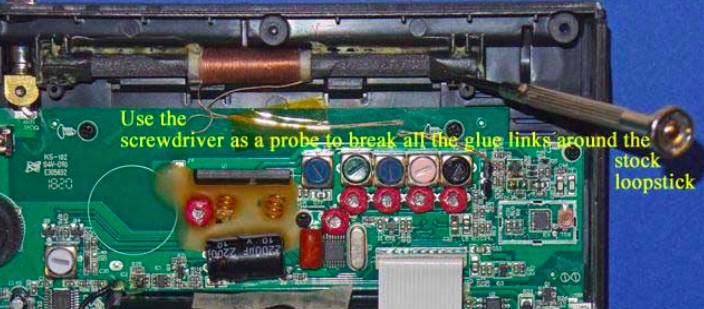
11) Refer to the photo below. Using the flat Jeweler’s screwdriver, once all of the glue bonds have been broken and the ferrite rod is loose in its slot, lift the ferrite rod out of its slot on one side by prying up under the plastic cover on the end of the ferrite rod. Ensure that the Litz wire leads have either been cut or desoldered from the circuit board, then grasp the ferrite rod with your fingers and pull it completely out of the slot with a slight twisting motion.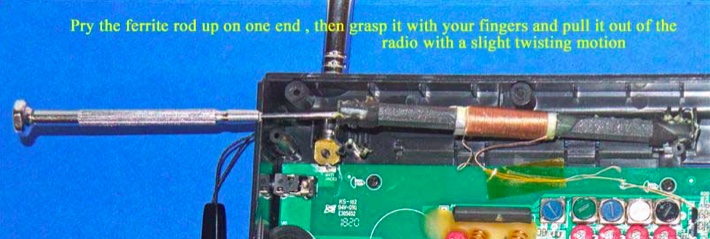
12) Remove the wrist strap, and refer to the photo below. Carefully pick up the two sides of the radio and place the back section in a vertical position as shown, with a heavy flat weight (barbell, or other heavy flat item) pressing up against the back cabinet section to keep it in a vertical position. Ensure that there is adequate, even lighting on the top cabinet section for the gluing process in the next step, and that the back cabinet surface will not shift around as you make the gluing “dry runs,” and perform the actual gluing of the loopstick frame to the top of the cabinet.
13) Take the previously prepared orange plastic loopstick frame, and ensure that its bottom glue surface is completely smooth and flat, with no uneven ridges on the edges of the glue surface (remove these with fine sandpaper, but ONLY on the ridges, and not on the rest of the flat glue surface). Using a damp paper towel, wipe the top cabinet glue surface and the loopstick frame glue surface to remove any dust or debris, then wipe them again with a dry, clean paper towel to ensure that they are both completely dry.
Take the loopstick frame and gently slide the frame over the top cabinet surface to ensure that both surfaces are smooth and flat. Refer to the photo at the top of the next page. Ensure that there is even, bright lighting on the top cabinet surface, and make several “dry runs” to place the loopstick frame in the exact center of the top cabinet surface (with 1/16”, or 1.5mm of space between the frame ends to the cabinet ends), and also 1/16” (1.5mm) of overhang above the front edge of the cabinet’s glue surface (NOTE: if you wish to simplify the process by lining up the front edge of the loopstick frame with the front edge of the cabinet’s glue surface it will still provide an acceptable result, but you will need to do some minor sanding of the whip antenna’s plastic slot post, as shown in the photo below. In either case, make repeated “dry runs” with the loopstick frame to practice placing it in the exact center of the top cabinet’s glue surface, since you will only get one chance to place it in the proper center position once the superglue is applied.
NOTE: The back of the loopstick frame has a beveled surface to permit full operation of the radio’s whip antenna after the frame is glued on the top of the cabinet surface. If the loopstick frame is glued with a 1/16” (1.5mm) overhang in front of the front edge of the cabinet surface then the whip antenna should have enough space for free operation. The alternative is to glue the two front edges lined up with each other to simplify the gluing process, in which case minor sanding may be required on the whip antenna slot post, as shown in the photo below.
14) After making multiple “dry runs” and becoming familiar with accurate placement of the loopstick frame on top of the cabinet, refer to the photo at the top of the next page. After once again ensuring that the back cabinet section will not shift around during the gluing process, take the Duro superglue packet and apply a thin (1/8”, or 3mm) bead of glue along the center of the cabinet’s glue surface, extending it 5 1/4” (133mm)long, with equal spaces on both ends (as shown). While sighting the two sides place the loopstick frame carefully down in the correct center position as practiced previously, with the 1/16” overhang if desired. If satisfied with the position, press down on the frame to lock the two surfaces together securely. Usually the frame may be shifted around slightly within 1 or 2 seconds of placing it on the superglue, so use this brief time to promptly shift the frame to a straight position, if necessary. After a couple of seconds, though, you will need to be satisfied with whatever position the frame has ended up with (regardless, it will still hold the loopstick just fine, for DXing purposes).
15) After the loopstick frame is securely placed and locked on top of the D-808’s cabinet surface, place downward pressure on the loopstick frame along its length in order to ensure a tight glue bond throughout the entire top cabinet surface. Continue this process for about one minute, and sight both ends of the loopstick frame to ensure that they are both completely flat against the D-808 cabinet.
16) Inspect the front and back edges of the loopstick frame’s border with the D-808 cabinet for any glue seepage, and if any is found, remove it promptly with the 1/16” flat Jeweler’s screwdriver blade. Glue should not be allowed to run past the frame edges. This completes the process of gluing the frame to the D-808 cabinet.
7.5” Loopstick Installation
17) [NOTE: The installation procedures of the Medium Wave (AM) and Longwave loopsticks are identical, except that the plastic tie wraps and rubber hose sections are closer to the ends of the ferrite rod in the Longwave version. The following photos are for the Medium Wave (AM) version, but Longwave loopstick builders should follow the same steps, while referring to the Longwave model photo in the “Operation” section as a guide]
Refer to the photo below. Carefully take the previously prepared 7.5” loopstick and hold it in the position shown—in its slot, centered in the middle of the orange antenna frame, with the shrink tubing and Litz wire leads running down to the left. Take the two plastic tie wraps and install them in the position shown, centered over the rubber hose sections on the loopstick, while ensuring that no Litz wires or shrink tubing is bound under the plastic tie wraps.
18) Refer to the photo below. Lay the two cabinet sections down flat as shown, ensuring that the Litz wire shrink tubing is in the exact position shown (if it isn’t, carefully slide it along both Litz wires until it is in this exact position). Carefully thread one Litz wire end through the empty wrist strap hole, then thread the other Litz wire end through the hole, as shown. Finally pull on the two Litz wires together from the right while guiding the end of the shrink tubing into the empty wrist strap hole, and pull a short section of the shrink tubing through the hole (as shown) to protect the Litz wire insulation from friction damage.
19) Refer to the photo below. Using the previous procedure to install shrink tubing (which is described in the PL-380 transplant article) install a 2.5” (63mm) length of shrink tubing over the two Litz wire ends, and shift the shrink tubing into the position shown in the photo. After this is done cut the two Litz wire leads to the lengths shown in the photo (NOTE: make sure that the ends of both Litz wires are cleanly cut, not frayed and at the minimum diameter before attempting to insert them into the shrink tubing. The process is much easier when the Litz wires pass smoothly through the shrink tubing).
20) Refer to the close up photo below. Using a low heat (25w) pencil-type soldering iron, remove the two stock Litz wire leads at the positions shown, taking care not to use excessive heat, or touch the adjacent components. Ensure that the new Litz wire leads are at the length shown when the leads are in a horizontal position throughout the cabinet, and cut them to this length if they are not.
21) NOTE: When tinning the 250/46 Litz wire it is essential that all of the individual Litz wire strands be completely soldered together for a length of at least 1/4” (6mm), with bright, shiny solder around the circumference of the Litz wire ends for this minimum (1/4”) length. The Litz wire must be heated with a clean, hot soldering iron around its circumference in order to melt the solder properly for this step]
Refer to the photo above. Pull the Litz wires up out of the previous position, and place a clean rag underneath them (on top of the circuit board) to completely protect the circuit board from any solder which might accidentally drop down during the tinning process. Using your hot 25w soldering iron melt a generous amount of solder on its tip, and work the soldering iron tip slowly and patiently around the circumference of each Litz wire end until there is a bright, shiny solder length of at least 1/4” (6mm) in a cylindrical pattern at the end of each Litz wire. When doing this, take great care not to allow any solder to drip down onto the circuit board below (i.e., make sure that your rag completely covers the circuit board). The final appearance of your Litz wire lead ends should resemble those in the photo.
22) When your Litz wire lead ends resemble the photo above, cut the soldered portion down to a length of 3/16” (5mm) and observe the appearance of the end of the Litz wire. It should have a bright, solid circular shape, with no gaps or individual Litz wires showing. If not, reheat the end of the Litz wire while adding some solder, and repeat this step.
23) NOTE: The Litz wire connection points on the circuit board are surrounded by other important components. It is important to avoid solder drips on these components, or solder bridges to their leads. Solder the Litz wire leads down at an angle to avoid these surrounding components, and use the minimum amount of heat and solder to ensure good electrical connections)
Refer to the close up photo above. Following the precautions described, solder the two Litz wire leads down onto the circuit board at an angle, as shown in the photo. After soldering, make a close visual inspection to ensure that there are no solder bridges across the Litz wire connections, or nearby components. The remaining length of the Litz wire leads should be routed in a horizontal manner to the wrist strap hole.
24) Carefully pick up the front and back cabinet sections, and hold the back cabinet section fairly close to the front section (as the radio would normally be oriented, when assembled). Refer to the photo below, and carefully insert the “Fine Tuning” control thumbwheel from the front cabinet section into its slot on the back cabinet section in a sideway movement. This will allow you to fully close the front and back cabinet sections in the next step.
25) Refer to the photo below. Pick up the two cabinet halves and carefully snap them together (this action should not require any great force). Place the radio face down in the position shown (with a soft surface underneath, for protection), and using the Jewelers Phillips screwdriver of the correct size, carefully screw in the six screws that were loosened previously, starting with the screw near the whip antenna post (you should pick up the radio temporarily and hold the two cabinet sections together tightly at this corner, as you do this).
After all six screws have been retightened take the Tuning control knob and press it back onto its shaft in a straight horizontal motion. Finally, reinstall the battery and battery compartment cover to finish up the reassembly.
TESTING AND OPERATION– MEDIUM WAVE MODEL
This 7.5” transplant loopstick is designed to provide a major boost in sensitivity from 530-1700 kHz, and if the antenna is working properly both the weak signal reception and the radio’s nulling capability should be greatly enhanced. It is normal for the antenna to receive more background noise on the low band frequencies, although the sensitivity boost should be substantial across the band.
The construction design of the orange antenna frame allows full usage of the whip antenna for checking SW parallels of MW-DX stations, although if you chose to glue the antenna frame flush with the front of the back cabinet surface to simplify the gluing process, you may need to sand the whip antenna slot post slightly to allow free movement of the whip antenna (see step #13).
In the photo above, some of the important controls for Medium DXing are highlighted. The AM Bandwidth control allows you to choose multiple DSP filtering selections to enhance selectivity as desired, with the narrowest filtering (1 kHz) providing both the sharpest selectivity and the best weak-signal sensitivity. However this 1 kHz setting also has the poorest audio fidelity, with the higher audio frequencies typically cut off by the DSP filtering. As such, for regular DXing far away from strong local pests, the other AM Bandwidth settings may be more suitable. The Direct Frequency Entry key allows you to manual enter in any MW frequency, to which the radio will shift once the numbers are pressed on the keypad. The Tuning knob has three different modes, which can be toggled by pressing the knob horizontally. The first mode is tuning in either 9 kHz or 10 kHz steps (depending on which of these step you have selected), while the second mode is tuning in 1 kHz steps. The third mode is to lock the frequency in place. Pressing the knob again will return the tuning to 9 or 10 kHz steps.
The XHDATA D-808 has multiple display functions, which can be toggled by the indicated key. The first option is the temperature in either Centigrade or Fahrenheit (depending on your pre-set preference), while the second option is the alarm time. The third option is the current time (which you need to set according whether you prefer UTC or local time), while the fourth option is the received signal strength in both dBu and dB.
The supplied 3.7v lithium ion battery has superior run time, and may be easily charged using the supplied USB cable to either a computer or AC outlet (with the appropriate adapter). As reported in various posts throughout this year, the D-808 model has rugged construction with an excellent record of survival under tough conditions, including hot summer days, moderate rain exposure and extended usage as the main receiver during a 9-day ocean cliff DXpedition in Oregon—performing flawlessly at all times.
Conclusion
It is the author’s sincere hope that this “Supercharged” D-808 model will bring you a lot of DXing fun during travel, as well as at other times. When conditions are good you should never underestimate this enhanced model’s potential of receiving awesome DX beyond your expectations—as an example, here is the stand-alone performance of a 7.5” loopstick D-808 in receiving 1017-A3Z in Nuku’alofa, Tonga (10 kW at 5,632 miles/ 9,063 km) on the ocean cliff near Manzanita, Oregon at 1301 UTC on August 8th of this year:
Not only Tonga is received, but even the Australian horse racing station 1017-2KY in Sydney (5 kW at 7,630 miles/ 12,280 km) is received as a weak co-channel in the middle of the recording. My hope is that you all will be so lucky with your new Supercharged D-808!
73 and Good DX,
Gary DeBock (in Puyallup, WA, USA)
Absolutely amazing! Thank you for taking the time to put this procedure together and describing the process in such fine detail, Gary! Hats off to you!
Click here to read all of Gary DeBock’s posts on the SWLing Post.

